TCT Mobile 012 GSM 900/1800/1900 Mobile Phone User Manual CTH3 UM FCC 15 03 05
TCT Mobile Limited GSM 900/1800/1900 Mobile Phone CTH3 UM FCC 15 03 05
User Manual
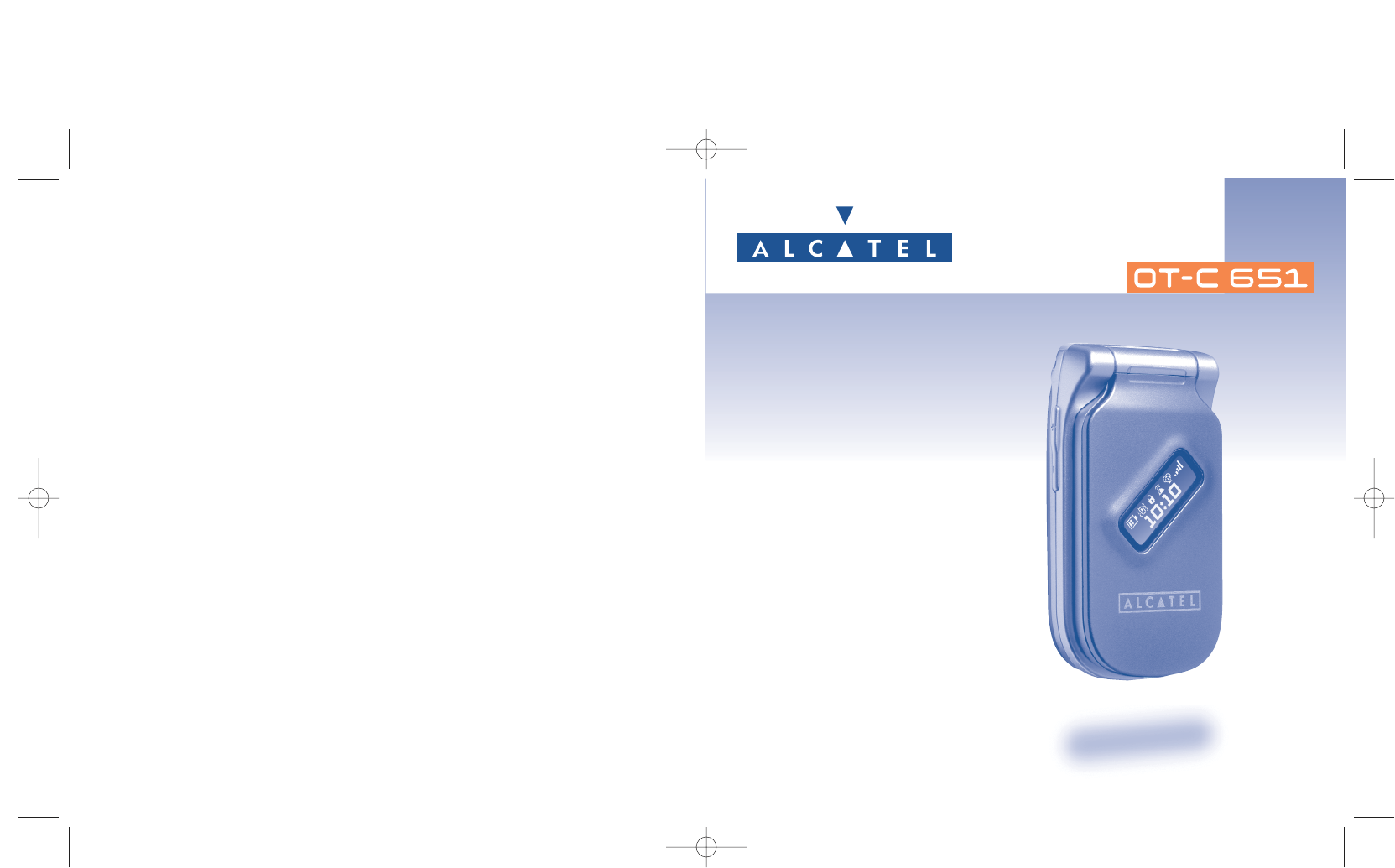
CTH3_UM_FCC_15-03-05 15/03/05 9:17 Page 1

Introduction ..........................................................
TCL & Alcatel Mobile Phones would like to thank you for purchasing this mobile.
Your camera: photo and video
You can take photos in a burst shoot and play a video clip with sound. Save it in your multimedia album and
use it to personalise the idle screen. You can also assign a video to a contact so that when your contact calls
you, the video is played. Capture and share your favourite moments with the camera. You can zoom and
record sound while taking your photos, or add funny frames and stamps. It is easy and a lot of fun!
Say it with colours using MMS
Your phone includes the Multimedia Message Service enabling you to send video clips, colour pictures and
sounds in your text messages. You can create expressive messages to match your mood thanks to the
embedded and downloaded multimedia content.
A style of your very own
Personalise your handset, giving it a personal touch. Either choose the colour and texture of your interface
from the embedded skins, or choose a video clip, a wallpaper or melody from the rich multimedia content.
Your game companion
Get ready for a new intense gaming experience with a large choice of downloadable games and applications.
1
Table of contents ..................................................
Introduction ....................................................................................................................1
Safety and Use ................................................................................................................5
General Information ......................................................................................................8
1. Your mobile ..............................................................................................................9
1.1 Keys ..................................................................................................................................................................10
1.2 External display icons ..................................................................................................................................11
1.3 Main screen icons..........................................................................................................................................12
2. Getting started ......................................................................................................13
2.1 Set-up ..............................................................................................................................................................13
2.2 Switching on your telephone......................................................................................................................15
2.3 Switching off your telephone......................................................................................................................15
3. Calls ........................................................................................................................16
3.1 Making a call....................................................................................................................................................16
3.2 Calling your voicemail ..................................................................................................................................17
3.3 Receiving a call ..............................................................................................................................................17
3.4 During the call................................................................................................................................................18
3.5 Conference calls ............................................................................................................................................20
3.6 Double line (ALS) .........................................................................................................................................20
4. Call Log ..................................................................................................................21
4.1 Call memory ..................................................................................................................................................21
4.2 My Numbers ..................................................................................................................................................22
4.3 My e-mail ........................................................................................................................................................22
4.4 Billing ................................................................................................................................................................22
4.5 Call settings ....................................................................................................................................................24
5. Menu........................................................................................................................27
6. Directory ................................................................................................................29
6.1 Consulting your directory ..........................................................................................................................29
6.2 Creating a contact.........................................................................................................................................30
6.3 Available options ...........................................................................................................................................31
6.4 Creating a new directory ............................................................................................................................32
6.5 Voice tag..........................................................................................................................................................32
6.6 Assigning a ringtone to a directory ..........................................................................................................33
2
CTH3_UM_FCC_15-03-05 15/03/05 9:17 Page 1

13. Media Album ..........................................................................................................75
13.1 Album menu ..................................................................................................................................................75
13.2 My Images........................................................................................................................................................75
13.3 My Videos ......................................................................................................................................................77
13.4 My Sounds ......................................................................................................................................................77
13.5 Managing sounds, images and videos ......................................................................................................78
13.6 Download new videos, photos, sounds, .................................................................................................79
13.7 Formats and compatibility ..........................................................................................................................80
14. Camera ..................................................................................................................81
14.1 Taking a photo ..............................................................................................................................................81
14.2 Burst shoots ..................................................................................................................................................82
14.3 Taking a photo with sound ........................................................................................................................82
14.4 Photo settings ................................................................................................................................................83
14.5 Options available after taking the photo ................................................................................................87
14.6 Modifying images............................................................................................................................................87
15. Video camera ........................................................................................................88
15.1 Framing mode ................................................................................................................................................89
15.2 Recording mode ............................................................................................................................................89
15.3 Playing mode ..................................................................................................................................................90
16. Games & Applications ..........................................................................................91
16.1 Launch an application ..................................................................................................................................91
16.2 Available options ..........................................................................................................................................92
16.3 Download an application ............................................................................................................................92
16.4 Java™ Push ....................................................................................................................................................93
16.5 Settings ............................................................................................................................................................93
17. Making the most of your mobile..........................................................................95
17.1 “My One Touch” services by TCL & Alcatel Mobile Phones ............................................................95
17.2 Alcatel PC suite ............................................................................................................................................95
18. Characters and symbols table..............................................................................96
19. Telephone warranty ..............................................................................................97
20. Accessories ............................................................................................................99
21. Troubleshooting ..................................................................................................100
4
6.7 Assigning an image, an animation or a video to a file ..........................................................................33
6.8 Privacy..............................................................................................................................................................33
7. Messages ................................................................................................................34
7.1 Receiving and reading messages ................................................................................................................35
7.2 Creating and sending messages .................................................................................................................38
7.3 Speed writing system....................................................................................................................................44
7.4 Parameters ......................................................................................................................................................46
7.5 Deleting messages ........................................................................................................................................48
8. My settings ............................................................................................................49
8.1 Ringtones.........................................................................................................................................................49
8.2 Display..............................................................................................................................................................50
8.3 Clock ................................................................................................................................................................54
8.4 Customising the keys ..................................................................................................................................54
8.5 More settings..................................................................................................................................................55
9. My Shortcuts ..........................................................................................................60
10. Tools ........................................................................................................................61
10.1 Diary ................................................................................................................................................................61
10.2 Alarms..............................................................................................................................................................64
10.3 Converter........................................................................................................................................................65
10.4 Calculator........................................................................................................................................................65
10.5 Memory............................................................................................................................................................66
10.6 Voice memo ..................................................................................................................................................66
10.7 Infrared ............................................................................................................................................................67
10.8 Alarms list ......................................................................................................................................................67
10.9 Tone composer ............................................................................................................................................68
10.10 Voice tag ......................................................................................................................................................69
11. Tips&tricks ............................................................................................................70
12. WAP ......................................................................................................................71
12.1 Access WAP menu ......................................................................................................................................71
12.2 Programming your access ..........................................................................................................................71
12.3 Direct access/profile access ......................................................................................................................73
12.4 GPRS function ................................................................................................................................................73
12.5 WAP browser options ................................................................................................................................74
3
CTH3_UM_FCC_15-03-05 15/03/05 9:17 Page 3

Some people may suffer epileptic seizures or blackouts when exposed to flashing lights, or when playing video games. These seizures or
blackouts may occur even if a person never had a previous seizure or blackout. If you have experienced seizures or blackouts, or if you have
a family history of such occurrences, please consult your doctor before playing video games on your phone or enabling a flashing-lights feature
on your phone. Parents should monitor their children’s use of video games or other features that incorporate flashing lights on the phones. All
persons should discontinue use and consult a doctor if any of the following symptoms occur: convulsion, eye or muscle twitching, loss of
awareness, involuntary movements, or disorientation. To limit the likelihood of such symptoms, please take the following safety precautions:
- Do not play or use a flashing-lights feature if you are tired or need sleep.
- Take a minimum of a 15- minute break hourly.
- Play in a room in which all lights are on.
- Play at the farthest distance possible from the screen.
When you play games on your phone, you may experience occasional discomfort in your hands, arms, shoulders, neck, or other parts of your
body. Follow these instructions to avoid problems such as tendinitis, carpal tunnel syndrome, or other musculoskeletal disorders:
- Take a minimum of a 15 minute-break every hour of game playing.
- If your hands, wrists, or arms become tired or sore while playing, stop and rest for several hours before playing again.
- If you continue to have sore hands, wrists, or arms during or after playing, stop the game and see a doctor.
• PRIVACY:
Please note that you must respect the laws and regulations in force in your country regarding taking photographs and recording sounds using
your cellphone. Pursuant to such laws and regulations, it may be strictly forbidden to take photographs and/or to record the voices of other
people or any of their personal attributes, and reproduce or distribute them, as this may be considered to be an invasion of privacy. It is the
user's sole responsibility to ensure that prior authorization be obtained, if necessary, in order to record private or confidential conversations
or take a photograph of another person; the manufacturer, the seller or vendor of your cellphone (including the operator) disclaim any liability
which may result from the improper use of the cellphone.
• BATTERY:
Before removing the battery from your phone, please make sure that the phone is switched off.
Observe the following precautions for battery use:
- Do not attempt to open the battery (due to the risk of toxic fumes and burns).
- Do not puncture, disassemble or cause a short-circuit in a battery,
- Do not burn or dispose of a used battery in the garbage or store it at temperatures above 60 °C.
Batteries must be disposed of in accordance with locally applicable environmental regulations. Only use the battery for the purpose for which
it was designed. Never use damaged batteries or those not recommended by TCL & Alcatel Mobile Phones Limited and/or its affiliates.
•CHARGERS:
Mains powered chargers will operate within the temperature range of: 0°C to 40°C.
The chargers designed for your cellphone meet with the standard for safety of information technology equipment and office equipment use.
They should be used for this purpose only.
6
Safety and Use ......................................................
We recommend that you read this chapter carefully before using your phone. The manufacturer disclaims any liability for damage, which may
result as a consequence of improper use or use contrary to the instructions contained herein.
•TRAFFIC SAFETY:
Given that studies show that using a cellphone while driving a vehicle constitutes a real risk, even when the hands-free kit is used (car kit,
headset...), drivers are requested to refrain from using their cellphone when the vehicle is not parked.
When switched on, your phone emits electromagnetic waves that can interfere with the vehicle’s electronic systems such as ABS anti-lock
brakes or airbags. To ensure that there is no problem:
- do not place your phone on top of the dashboard or within an airbag deployment area,
- check with your car dealer or the car manufacturer to make sure that the car’s electronic devices are shielded from cellphone RF energy.
•CONDITIONS OF USE:
Switch the phone off before boarding an aircraft to avoid prosecution.
Switch the phone off when you are in health care facilities, except in designated areas. As with many other types of equipment now in regular
use, cellphones can interfere with other electrical or electronic devices, or equipment using radio frequency.
Switch the phone off when you are near gas or flammable liquids. Strictly obey all signs and instructions posted in a fuel depot, gas station, or
chemical plant, or in any potentially explosive atmosphere.
When the phone is switched on, it should be kept at least 15 cm from any medical device such as a pacemaker, a hearing aid or insulin pump.
In particular when using the phone you should hold it against the ear on the opposite side to the device, if any.
To avoid hearing impairment, pick up the call before holding your phone to your ear. Also move the handset away from your ear while using
the “hands-free” option because the amplified volume might cause hearing damage.
Do not let small children use your cellphone without supervision.
When replacing the cover please note that your phone may contain substances that could create an allergic reaction.
Always handle your phone with care and keep it in a clean and dust-free place.
You are advised to switch off the telephone from time to time to optimise its performance.
Do not allow your phone to be exposed to adverse weather or environmental conditions (moisture, humidity, rain, infiltration of liquids, dust,
sea air, etc.). The manufacturer’s recommended operating temperature range is -20°C to +55°C. Over 55°C the legibility of the phone’s display
may be impaired, though this is temporary and not serious.
Do not open or attempt to repair your cellphone yourself.
Do not drop, throw or try to bend your cellphone.
Do not paint it.
Use only Alcatel batteries, battery chargers, and accessories that are compatible with your phone model. (See Accessories List, chapter 99).
TCL & Alcatel Mobile Phones Limited and its affiliates disclaim any liability for damage caused by the use of other chargers or batteries.
Your phone should not be disposed of in a municipal dump. Please check local regulations for disposal of electronic products.
Remember to make back-up copies or keep a written record of all important information stored in your phone.
5
CTH3_UM_FCC_15-03-05 15/03/05 9:17 Page 5

General Information ............................................
•Web site: www.tcl-alcatel-mp.com - WAP address: wap.tcl-alcatel-mp.com
•Hot Line Number: see “TCL & Alcatel Mobile Phones Services” leaflet or go to our Internet site.
On our Internet site, you will find our FAQ (Frequently Asked Questions) section. You can also contact us
my e-mail to ask any questions you may have.
An electronic version of this user guide is available in English and other languages according to availability on
our server: www.tcl-alcatel-mp.com
Your telephone is a transceiver that operates on GSM networks with 900, 1800 and 1900 MHz bands.
The marking indicates that your telephone complies with "1999/5/EC (R&TTE)" directive and that the
accessories concerned comply with current EC directives. The entire copy of the Declaration of Conformity
for your telephone can be obtained through our website: www.tcl-alcatel-mp.com.
Protection against theft (1)
Your telephone is identified by an IMEI (phone serial number) shown on the packaging label and in the
product’s memory. We recommend that you note the number the first time you use your telephone by
entering , , , , and keep it in a safe place. It may be requested by the police or your
operator if your telephone is stolen. This number allows your mobile telephone to be blocked preventing a
third person from using it, even with a different SIM card.
February 2005
8
Characteristics of power supply (depending on the country):
• 110 V charger (used in Mexico): • 220 V charger:
Input: 100-127 V, 50/60 Hz, 0.30 A Input: 220-240 V, 50/60 Hz, 0.30 A
Output: 4.5 V, 350 mA Output: 4.5 V, 350 mA
• Travel charger: • Battery: Lithium 3,7V 650mAh
Input: 100-240 V, 50/60 Hz, 0.15 A
Output: 6.5 V, 350 mA
•RADIO WAVES:
THIS CELLPHONE MEETS THE GOVERNMENT’S REQUIREMENTS FOR EXPOSURE TO RADIO WAVES.
Your cellphone is a radio transmitter and receiver. It is designed and manufactured not to exceed the emission limits for exposure to radio-
frequency (RF) energy. These limits are part of comprehensive guidelines and establish permitted levels of RF energy for the general population.
The guidelines are based on standards that were developed by independent scientific organizations through periodic and thorough evaluation of
scientific studies. These guidelines include a substantial safety margin designed to ensure the safety of all persons, regardless of age and health.
The exposure standard for cellphones employs a unit of measurement known as the Specific Absorption Rate, or SAR. The SAR limit set by
public authorities such as the Federal Communications Commission of the US Government (FCC), the Australian Communications Authority
(ACA) or by Industry Canada, is 1.6 W/kg averaged over 1 gram of body tissue. Tests for SAR are conducted using standard operating positions
with the phone transmitting at its highest certified power level in all tested frequency bands.
Although the SAR is determined at the highest certified power level, the actual SAR level of the phone while operating can be well below the
maximum value. This is because the phone is designed to operate at multiple power levels so as to use only the power required to reach the
network. In general, the closer you are to a wireless base station antenna, the lower the power output of the phone. Before a phone model is
available for sale to the public, compliance with national regulations and standards must be shown.
The highest SAR value for this model phone when tested for use at the ear is 0.32 W/Kg and for use close to the body is 0.96 W/Kg. While
there may be differences between the SAR levels of various phones and at various positions, they all meet the government requirement for RF
exposure. For body-worn operation, the phone meets FCC RF exposure guidelines provided that it is used with a non-metallic accessory with
the handset at least 1.5 cm from the body. Use of other accessories may not ensure compliance with FCC RF exposure guidelines.
The World Health Organization (WHO) considers that present scientific information does not indicate the need for any special precautions for
use of cellphones. If individuals are concerned, they might choose to limit their own or their children's RF exposure by limiting the length of
calls, or using "hands-free" devices to keep cellphones away from the head and body. (fact sheet n°193).Additional WHO information about
electromagnetic fields and public health are available on the following website: http://www.who.int/peh-emf.
Your telephone is equipped with a built-in antenna. For optimal operation, you should avoid touching it or degrading it (see page 14).
7
(1) Contact your network operator to check service availability.
CTH3_UM_FCC_15-03-05 15/03/05 9:17 Page 7
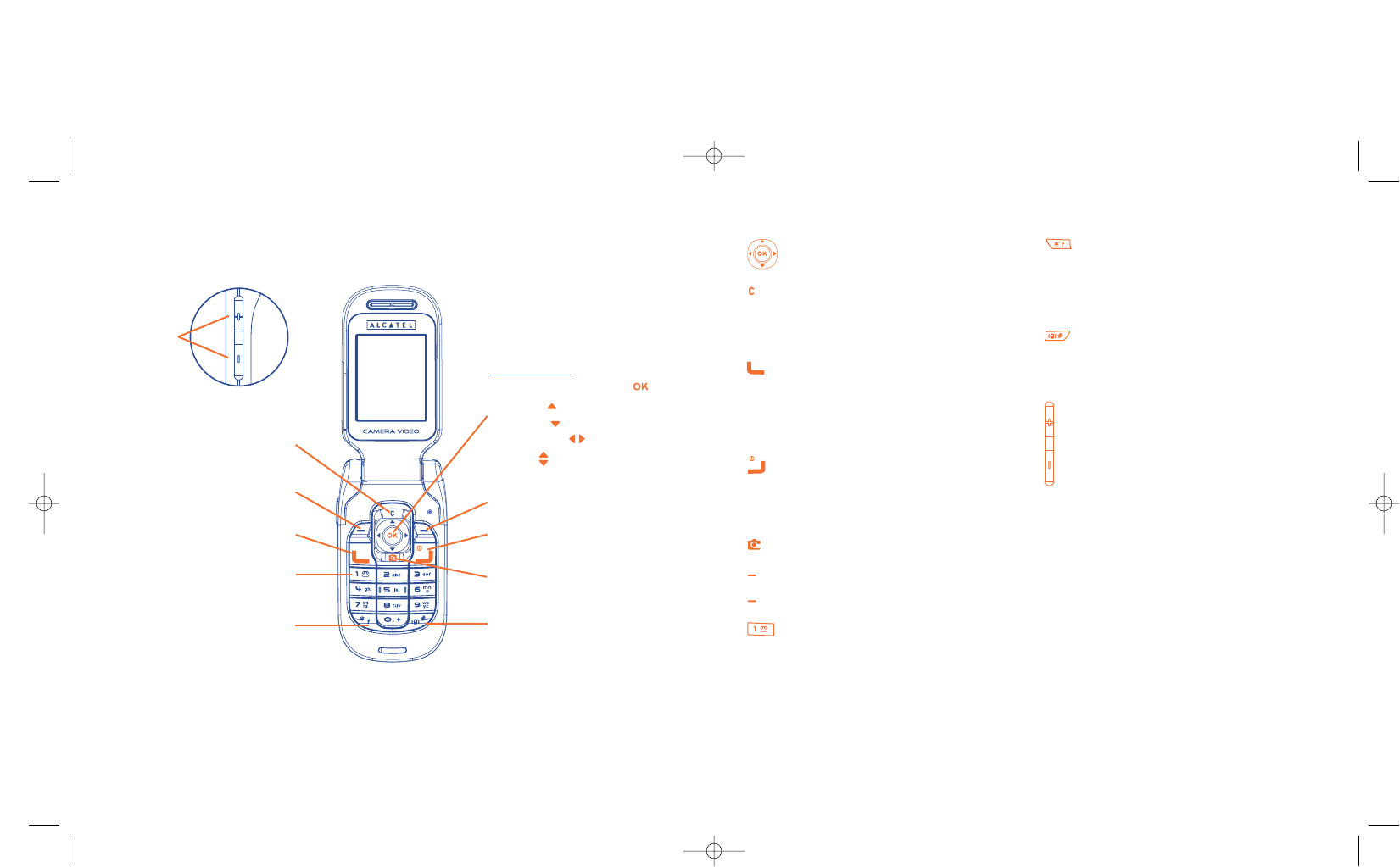
10
Navigation key
Confirm an option (central press)
Delete (short keypress)
Return to the previous screen (short
keypress)
Return to the main screen (long keypress)
Pick up
Send a call
Access call memory (Redial) (short
keypress)
Use voice tag features (long keypress)
Switch on the telephone (long keypress)
Switch off the telephone (long keypress)
End call
Return to the main screen
Personal key/Camera key/Operator key (1)
Left softkey
Right softkey
Consult your voicemail (long keypress)
In Edit mode:
- Short keypress: upper case, lower case,
digits
- Long keypress: switch from normal to
predictive mode
Long keypress from the main screen:
activate/deactivate the vibrator.
Short keypress in Edit mode: access the
symbols table.
Side keys:
Flip closed
- Switch on the backlight
- Scroll through the last calls list (headset
plugged in)
- Set the volume
Flip opened
- Access the camera from the main screen
- Take a photo (short press up or down)
- Take a burst shoot (long press up)
- Take a photo with sound (long press
down)
- Set the volume
1.1 Keys
(1) Depending on your network operator.
1Your mobile ..................................................
9
Personal key/Camera key/
Operator key (1)
Voicemail
Edit mode
Left softkey Right softkey
Clear
Back
Pick up/Send call
Call memory
Voice tag
Navigation key (1):
Menu/Confirm an option
Messages
Directory
Media Album
Volume
Access the symbols table
Vibrator
(1) Depending on your network operator.
Switch on/Switch off
End call
2 side keys
CTH3_UM_FCC_15-03-05 15/03/05 9:17 Page 9
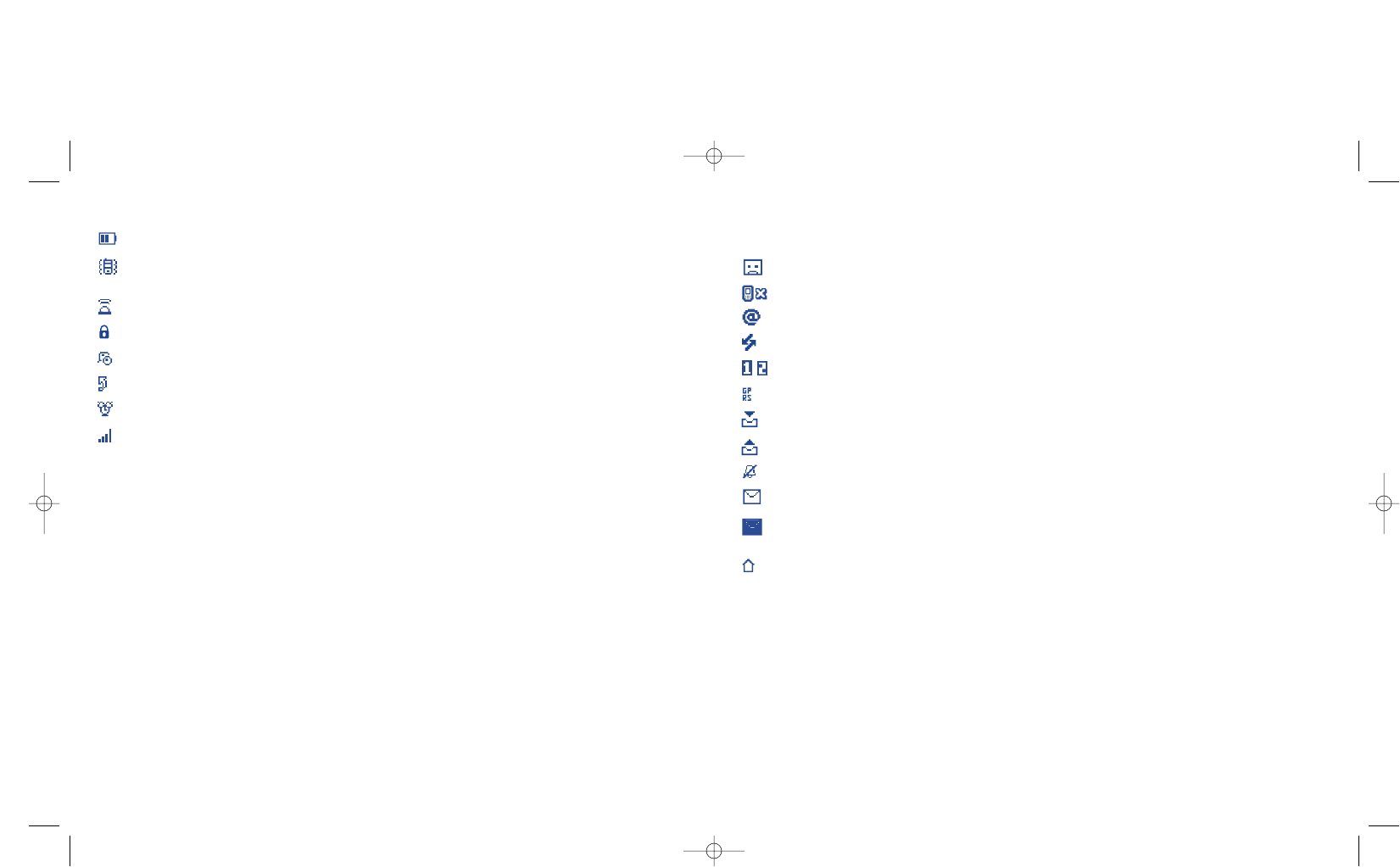
1.3 Main screen icons (1)
All external display's icons can be found with different size and colours on the main screen too.
Voicemail message arrived.
Unanswered calls.
WAP alerts (2).
Roaming within your country of subscription.
Double line (2): indicates the selected line.
GPRS context activated.
Reception of an MMS in progress.
Sending an MMS.
Silence mode: your phone neither rings, beeps nor vibrates except for the alarms (see page 50).
Message unread
Message list is full (SMS): your terminal cannot accept any new SMS. You must access the
message list and delete at least one message on your SIM card (see page 48).
Preferred tariff areas (2).
12
(1) The icons and illustrations in this guide are provided for informational purposes only.
(2) Contact your network operator to check service availability.
1.2 External display icons (1)
Battery charge level
Vibrator mode: your phone vibrates but neither rings nor beeps except for the alarms (see page
50).
Infrared: infrared link activated.
Keypad locked.
Push To Talk presence status (P2T) (2).
Call forwarding activated: your calls are forwarded (see page 24).
Timer or Alarm clock programmed (see page 64).
Level of network reception.
11
(1) The icons and illustrations in this guide are provided for informational purposes only.
(2) Depending on your network operator.
CTH3_UM_FCC_15-03-05 15/03/05 9:17 Page 11
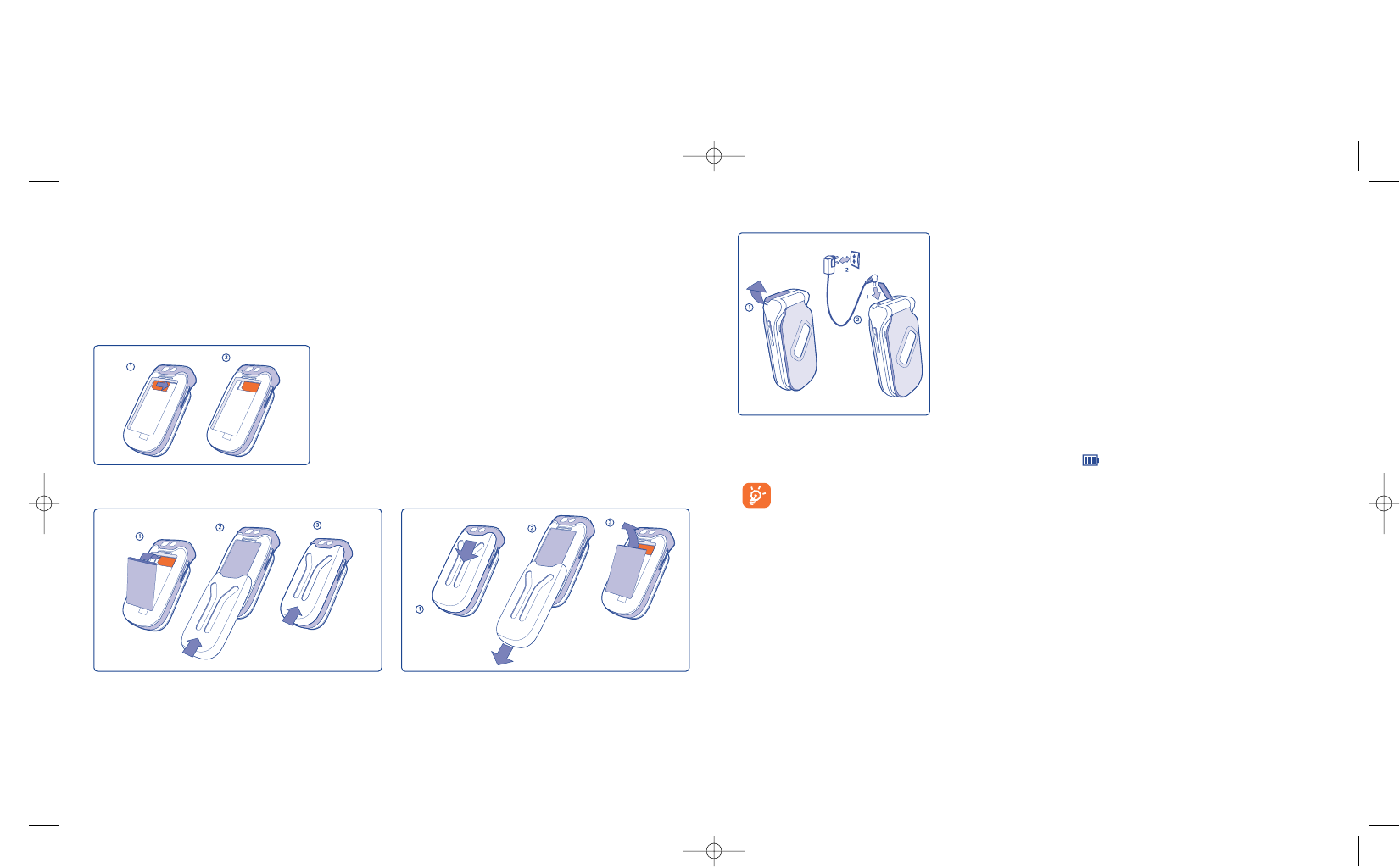
Charging the battery
Connect
the battery charger
•A short beep will sound when charging begins.
•The animation may take several minutes to start and may emit a
slight whistling sound if the battery is flat.
•Be careful not to force the plug into the socket.
•The battery icon will take a few minutes to indicate the correct
charge level.
•Make sure the battery is correctly inserted before connecting the
charger.
•The mains socket must be near to the phone and easily accessible
(avoid electric extension cables).
•When using your telephone for the first time, charge the battery
fully (approximately 3 hours). It is recommended that you charge
the telephone every day for optimal use. You are advised to fully
charge the battery ( ).
14
2Getting started ............................................
2.1 Set-up
Inserting and removing the SIM card (1)
You must insert your SIM card in order to use your phone.
13
Place the SIM card with the chip facing downwards and the cut-off
corner on the lower left hand side. Slide the card into its housing
and make sure that it is correctly inserted.
(1) Check with your network operator to make sure that your SIM card is 3V compatible. The old 5 Volt
cards can no longer be used. Please contact your operator.
Installing the battery Removing the battery
Insert and engage the battery, then close the
telephone cover.
CLICKCLICK
Unclip the cover, then the battery and remove it.
The charge is complete when the animation stops. Only use Alcatel chargers.
Precautions during use
Do not place your hand on the lower part of the mobile phone.
Your telephone is equipped with a built-in antenna. For optimal operation, you should avoid touching it or
damaging it.
For better radio reception and optimum operation, do not touch the lower part of your telephone.
CTH3_UM_FCC_15-03-05 15/03/05 9:17 Page 13
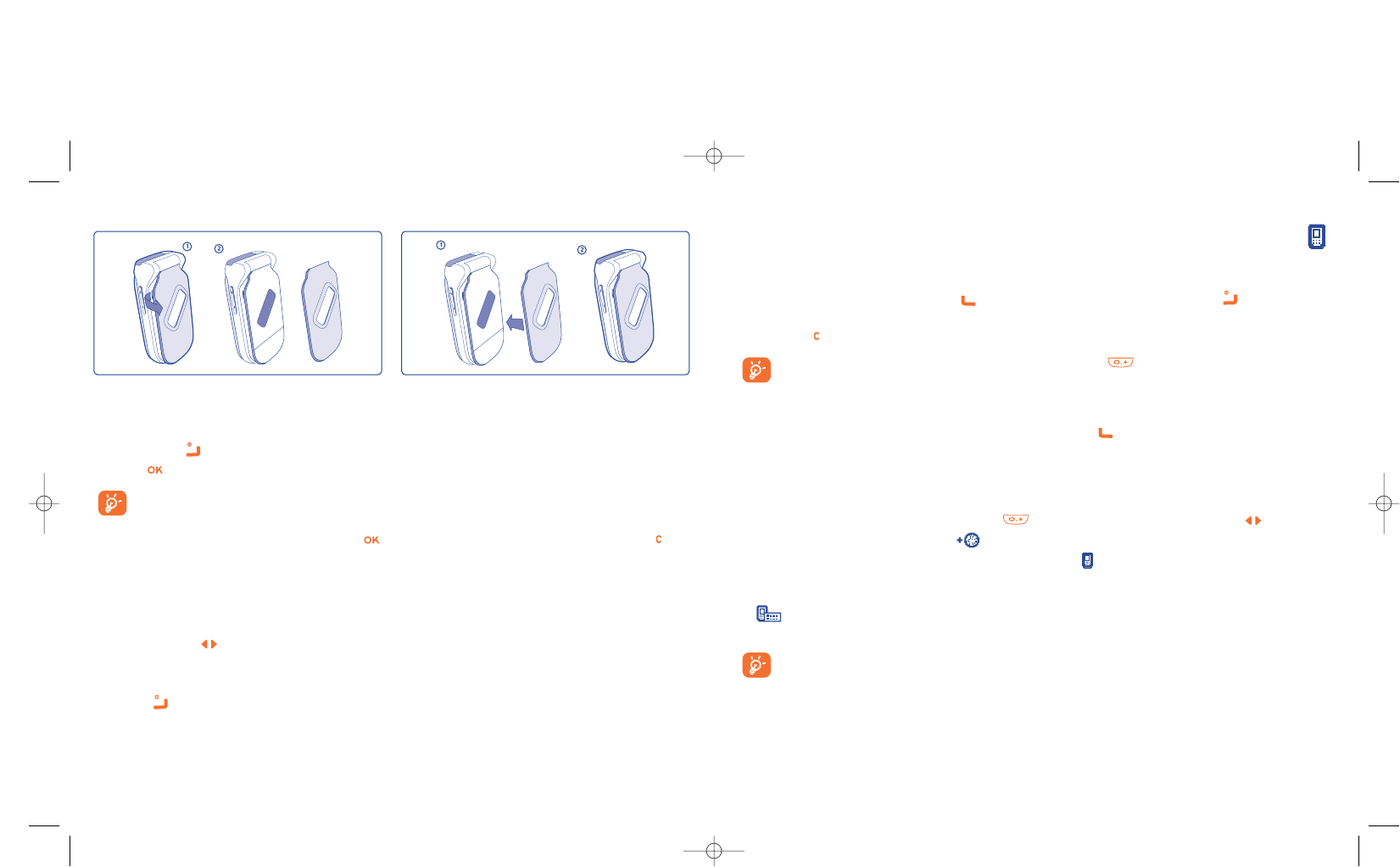
3Calls ..........................................................
3.1 Making a call
Dial the desired number then press the key to place the call. To hang up, press the key or close the
phone folder (except with headset plugged in). If you make a mistake, you can delete the incorrect digits by
pressing the key.
To enter characters “+” or “P” (pause), hold down the key (the following characters will
scroll by: 0, +, P, •).
Making an emergency call
If your phone is covered by the network, dial 112 and press the key to make an emergency call (or any
other number provided by your operator). This works even without a SIM card and without typing the PIN
code or unblocking the keypad.
Making a call with a prefix
To access the various prefixes, hold down the key, stop at the “+” sign and use the key.
• To make an international call, go to , select the country, finish dialling the number and send the call.
• If you already know the prefix you want, go directly to the icon and enter the prefix directly followed
by the number of the person you are calling.
• In some companies, telephone numbers all begin with the same digits. By using the “Prefix” feature
, you can save the shared digits, but you will need to enter the variable part. You must create the
prefixes yourself.
When the flip is closed with the headset plugged in, you can access the last calls (incoming and
outgoing) by pressing the headset key. With the side keys, you can scroll through the numbers one
by one that are shown on the external display. Press the headset key again to call the number you
have selected.
1615
2.2 Switching on your telephone
Hold down the key until the telephone comes on, type in your PIN code if necessary and then confirm
with the key. The main screen is displayed.
If you don’t know your PIN code or if you have forgotten it, contact your network operator. Do
not leave your PIN code near your telephone and store your card in a safe place when not in use.
If cell broadcast messages are displayed, use the key to browse through them in full or press the key
to return to the main screen.
While the phone is searching for a network, the <<<->>> symbol is displayed (???-??? is displayed if your SIM
card is rejected by the network; in this case please contact your operator).
From the switch on screen, you also have access to the “Video” demo function: select the left icon with
the navigation key . Even if no SIM card inside, you will have access to the video clips list.
2.3 Switching off your telephone
Press the key when on the main screen (long keypress).
Change the front belts
Open the front belt Close the front belt
CTH3_UM_FCC_15-03-05 15/03/05 9:18 Page 15
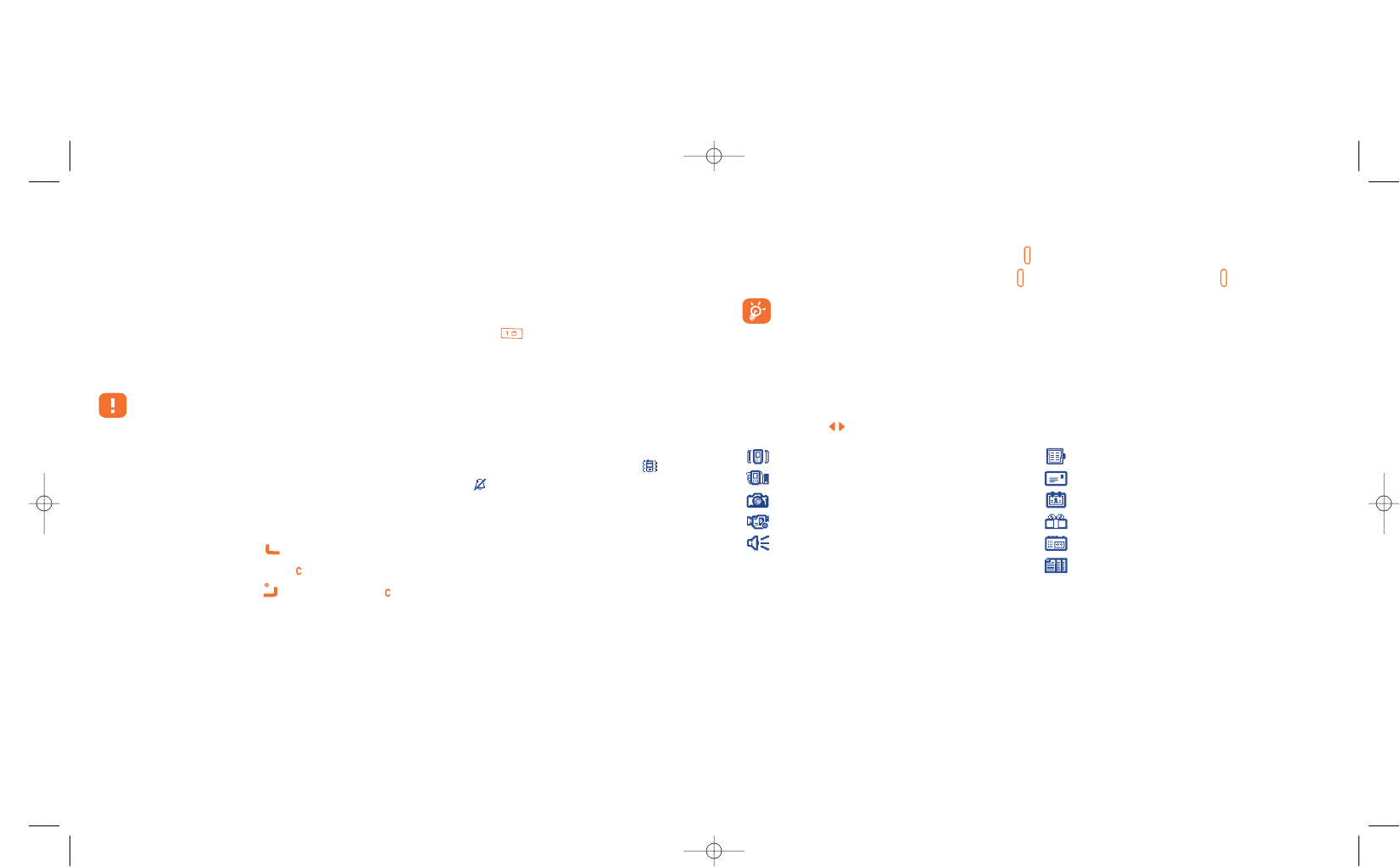
If the flip is closed
- To pick up a call, open the flip (Flip answer option activated)
- To mute the ringtone, press the lower side key once.
- To reject a call, hold down the lower side key once or press the lower side key twice.
The caller’s number is displayed if it is transmitted by the network (contact your network operator
to check service availability).
3.4 During the call
Functions available when the flip is open
During a call, you can use your directory, your diary, short messages, etc. without losing your correspondent
by pressing the key.
18
(1) Contact your network operator to check service availability.
Call on hold
Ongoing call
Take a picture
Video
Handsfree
WARNING: move the handset away from
your ear while using the “handsfree”
option because the amplified volume might
cause hearing damage.
Directory
Messages
Diary
Services (1)
Voice memo (record your current call).
Display notes
17
Automatic redial
If this feature is activated and supported by the network (see page 26), the person you called will be called
back automatically until he/she can be reached.
3.2 Calling your voicemail (1)
Your voicemail is provided by your network to avoid missing calls. It works like an answering machine and
you can consult it at any time. To access your voicemail, hold down the key.
If the access number for your operator’s voicemail service does not work, dial the number that you were
given. To change this number at a later date, refer to “My Numbers” (see page 22).
To use your voicemail service from abroad, contact your network operator before leaving.
3.3 Receiving a call
When you have an incoming call, your telephone rings quietly at first and then gets louder. If the icon
is displayed, the vibrator is activated and there is no ringtone. If the icon is displayed, the phone neither
rings nor vibrates.
If the flip is open
- To pick up a call, press the key.
- To mute the ringtone, press the key once or select “Options” (right softkey) then “Silence”.
- To reject a call, press the key once or the key twice or select “Options” (right softkey) then
“Reject”.
17
(1) Contact your network operator to check service availability.
CTH3_UM_FCC_15-03-05 15/03/05 9:18 Page 17

3.5 Conference calls (1)
Your phone allows you to talk to several people at the same time (up to 5). If you are on a double call, press
, select “Conference” then confirm with the key. If a third call comes in, answer it by pressing the
key and speak with your new correspondent.
This correspondent becomes a member of the conference if you press , select “Add conf.”, and then
confirm by pressing . Pressing disconnects the current call.
To end the conference call, press and select “End conf.” or close the flip.
3.6 Double line (ALS) (1)
Your SIM card can contain two distinct telephone numbers. Under “Call log”, choose “Double line” and
then select a default line; all your outgoing calls will be made from this number. Incoming calls, however, will
continue to use the two lines.
The services programmed on the default line do not impact those selected on the other line.
20
(1) Contact your network operator to check service availability.
19
Adjusting the volume
You can adjust the sound level during a call using the navigation key or the side keys.
Handling two calls
•Call waiting (1)
If a second call comes in while you are already on line, you will be notified by a tone. You can then accept
the call by pressing the key.
Your current call will be automatically put on hold. You can then switch between your two
correspondents using the key and then .
•Making a second call
To call a second party during a call, dial the number directly.
Headset plugged in: Closing the flip during the conference call won’t end any of your calls but
you won’t be able to manage them as long as your phone remains closed.
Take a picture
Short keypress on the key or select the camera icon using the key to take a photo and automatically
send it to your correspondent (2).
Video
With this option, soundless video will be recorded and automatically sent to your correspondent (2). Select
the video camera icon using the key or long press on the key to access the framing mode (press
the key to begin the recording).
19
(1) Contact your network operator to check service availability.
(2) Only if your correspondent’s number has been identified (not unknown or hidden…). The data will be
transmitted to your correspondent as you’ll hang up the call.
CTH3_UM_FCC_15-03-05 15/03/05 9:18 Page 19
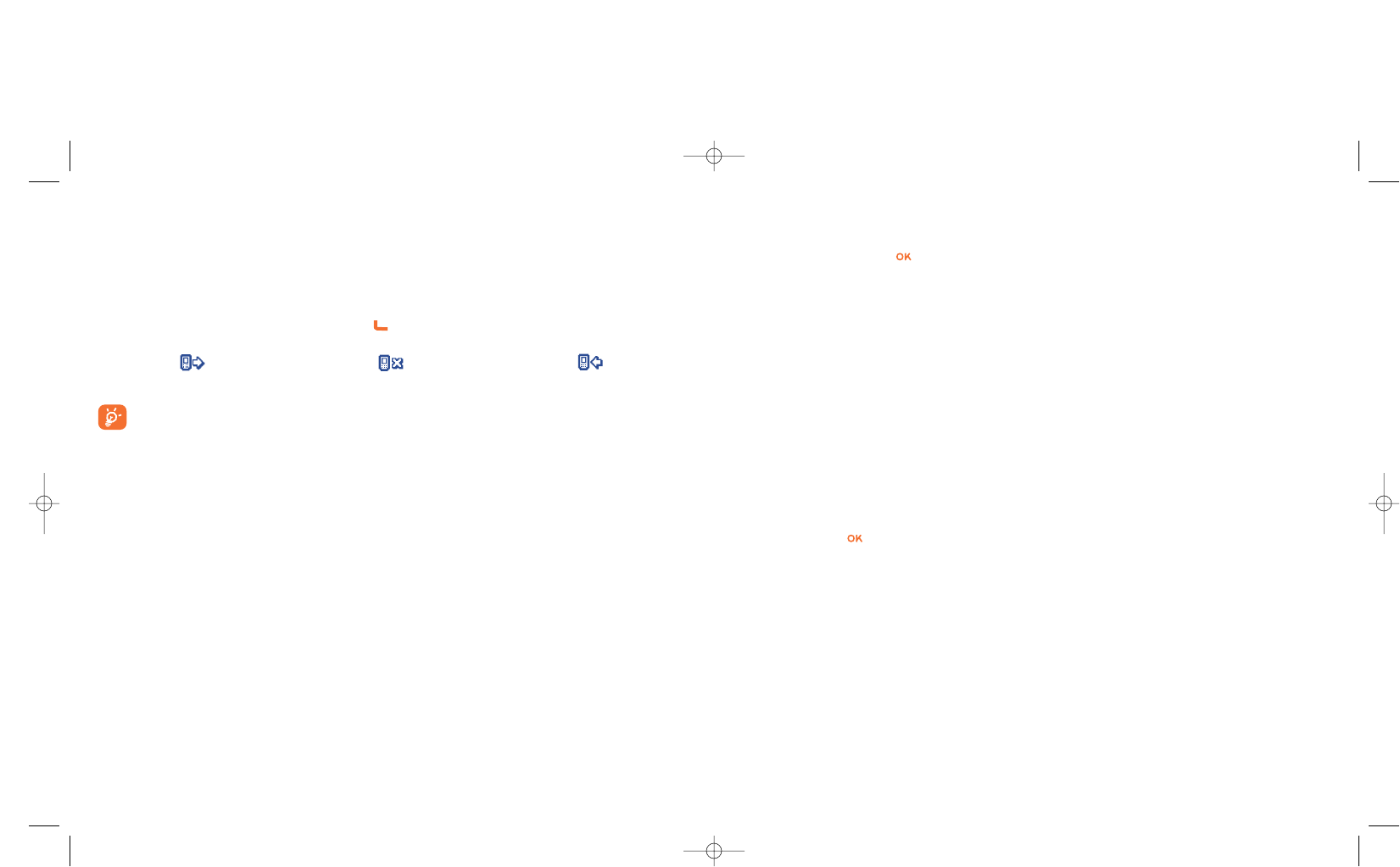
4.2 My Numbers
My Number Type in your telephone number (usually written on your SIM card) and confirm by
pressing .
Voicemail Type in or modify the number to access your voicemail.
4.3 My e-mail
Enter your own e-mail address to facilitate sending pictures, images, video clips, sounds... by MMS to your
PC.
You can do it also from the options while writing an MMS.
4.4 Billing
Amount (1) Management of call charges.
Total cost Total cost of charged calls.
Available Credit remaining of the “Maximum credit” amount.
credit (1)
Maximum Credit limit beyond which any billable call is barred (enter credit, then confirm by
credit (1) ).
22
(1) Contact your network operator to check service availability.
4Call Log ........................................................
4.1 Call memory
4.1.1 Flip opened
You can access your call memory by pressing the key from the main screen. You must first choose the
appropriate icon:
Outgoing calls (Redial) Unanswered calls Answered calls
The icons that may be displayed to the left of the person’s name show the type of telephone
number recorded in the directory (Home, Office, Mobile Phone).
Available options
From the stored number, you can access the following options using the right softkey:
View •Consult call details (number, date, time, etc.).
Write message •Send an SMS, MMS or Vox MMS to the selected number.
Save •Store the selected number in one of your directories.
Delete number •Delete the selected number.
Clear list •Clear the entire list.
4.1.2 Flip closed
When the flip is closed with the headset plugged in, you can access the last calls (incoming and outgoing) by
pressing the headset key. With the side keys, you can scroll through the numbers one by one that are shown
on the external display. Press the headset key again to call the number you have selected.
21
CTH3_UM_FCC_15-03-05 15/03/05 9:18 Page 21

Delete Reset all counters to zero.
Cost summary (1)
Last call Duration and cost of the last call.
Total cost Duration and cost of all calls.
Beep duration Activate (or cancel) the beep emitted during a call with a specified frequency (enter the
frequency and confirm by ).
4.5 Call settings
Call forward (1)
Voice Activate/cancel call forwarding to a specified number (type in the number, confirm by
pressing ). The following configurations are possible:
•Unconditional Systematic forwarding of all your calls. The icon is displayed.
•Conditional If your line is busy, if you don’t answer or if you are outside the network range.
•If busy Only if your line is busy.
•If no reply Only if you don’t answer.
•If unreachable Only if you are outside the range of the network.
Data Your data reception calls are systematically forwarded to a specified number.
Fax Your fax reception calls are systematically forwarded to a specified number.
Status List of call forwarding options activated on this telephone.
Cancel all Cancellation of all activated call forwarding options.
24
(1) Contact your network operator to check service availability.
23
Reset Reset total cost of charged calls.
Cost unit Cost of a Telecom Unit in the currency of your choice (Select the “Other?” option for
a new currency and use the key to enter a decimal point).
Duration Call duration management.
Total duration Total duration of all outgoing calls.
Avail. duration Time credit still available in relation to the duration provided by the “Set duration”
(amount provided for informational purposes only).
Set duration Contract duration (enter the duration then confirm by ).
Reset Reset to zero (immediately or periodically) the cumulative duration for outgoing calls.
GPRS Management of the volume of data communications charged for (in kilobytes).
counters
Global counter Total charges for data volume exchanged.
Access point Charges for data volume exchanged per access point.
•Access point 1-2 Charges for data volume exchanged through access point 1 or 2.
Cumulated Charges for data volume exchanged through all access points 1 or 2.
Last counter Charges for data volume exchanged through last access point 1 or 2.
Reset Reset to zero data volume exchanged through all access points 1 or 2.
•Other Charges for data volume exchanged through other access points.
Cumulated Charges for data volume exchanged through all access points.
Last counter Charges for data volume exchanged through the last access point.
Reset Reset to zero data volume exchanged through all access points.
CTH3_UM_FCC_15-03-05 15/03/05 9:18 Page 23

Calls
Call waiting (1) Activate/deactivate the notification of a second incoming call by a beep.
Conceal ID (1) Activate/deactivate the option making your calls anonymous (your number is no longer
(CLIR) transmitted by the network to the party you are calling).
Caller ID (1) Activate/deactivate the display of your caller’s number (or name if found in the directory)
(CLIP) for each call.
Pick up (1) Choose your pick up mode: key or any key.
Network auto Enables automatic callback by the network of the last dialled busy number.
redial (1)
Automatic redial (2)
Activate/ Activate/deactivate automatic callback of your party if the first call did not get through.
Deactivate
See list List of numbers for which automatic callback was not successful (10 unsuccessful
attempts).
Clear list Delete the list.
Double line (ALS) (1)
See page 20.
26
(1) Contact your network operator to check service availability.
(2) Depending on your country or your operator.
25
Call barring
Outgoing calls Activate/deactivate the call barring. This option is applied as follows:
•Except SIM Dir. Outgoing calls to numbers not included in your directory are barred.
•All (1) All outgoing calls are barred.
•International (1) Outgoing international calls are barred.
•Except->Home Outgoing international calls except those to your country of subscription are barred.
•Except FDN Barring of outgoing calls in accordance with a specific “FDN” (2) directory contained in
Dir. (1) the SIM card.
Activate/ All calls not beginning with one of the numbers recorded in the “FDN” directory are
Deactivate barred.
Change If the “Except FDN dir” feature has been activated, after entering PIN2, you can update
the “FDN” directory (update “FDN” directory by pressing ).
Incoming calls Activate/deactivate the barring of incoming calls. The following configurations are
possible:
•Except SIM dir. All calls from numbers not in your directory are barred.
•All (1) All incoming calls are barred.
•If abroad (1) Incoming calls are barred when you are abroad.
Status List of incoming call barring options activated on this phone.
(1) Contact your network operator to check service availability.
(2) FDN: Fixed Dialling Number.
CTH3_UM_FCC_15-03-05 15/03/05 9:18 Page 25

28
(1) Contact your network operator to check service availability.
• CALL LOG
- Call memory
- My Numbers
- My e-mail
- Billing
- Call settings
• MY SETTINGS
- Ringtones
- Display
- Clock
- Keys
- More settings...
- Tips&Tricks
• MY SHORTCUTS
• SERVICES
- Services (1)
- My one Touch
•WAP
- Homepage
- Bookmarks
- Profiles
- Enter address
- Tips&Tricks
• TIPS&TRICKS
5Menu (1) ..........................................................
• GAMES & APPS
• MEDIA ALBUM
- My Images
- My Videos
- My Sounds
- Games & Apps
- Memory
• TOOLS
- Diary
- Alarms
- Calculator
- Converter
- Memory
- Tone composer
- Voice memo
- Voice tag
- Infrared
- Alarms list
• PHOTO/VIDEO
- Take a picture
- Record a video
- My Images
- My Videos
- Tips&Tricks
• DIRECTORY
• MESSAGES
- Create message
- Inbox
- Outbox
- Voicemail
- Templates
- Parameters
- Memory
- Delete
- Tips&Tricks
27
(1) Depending on your network operator.
CTH3_UM_FCC_15-03-05 15/03/05 9:18 Page 27
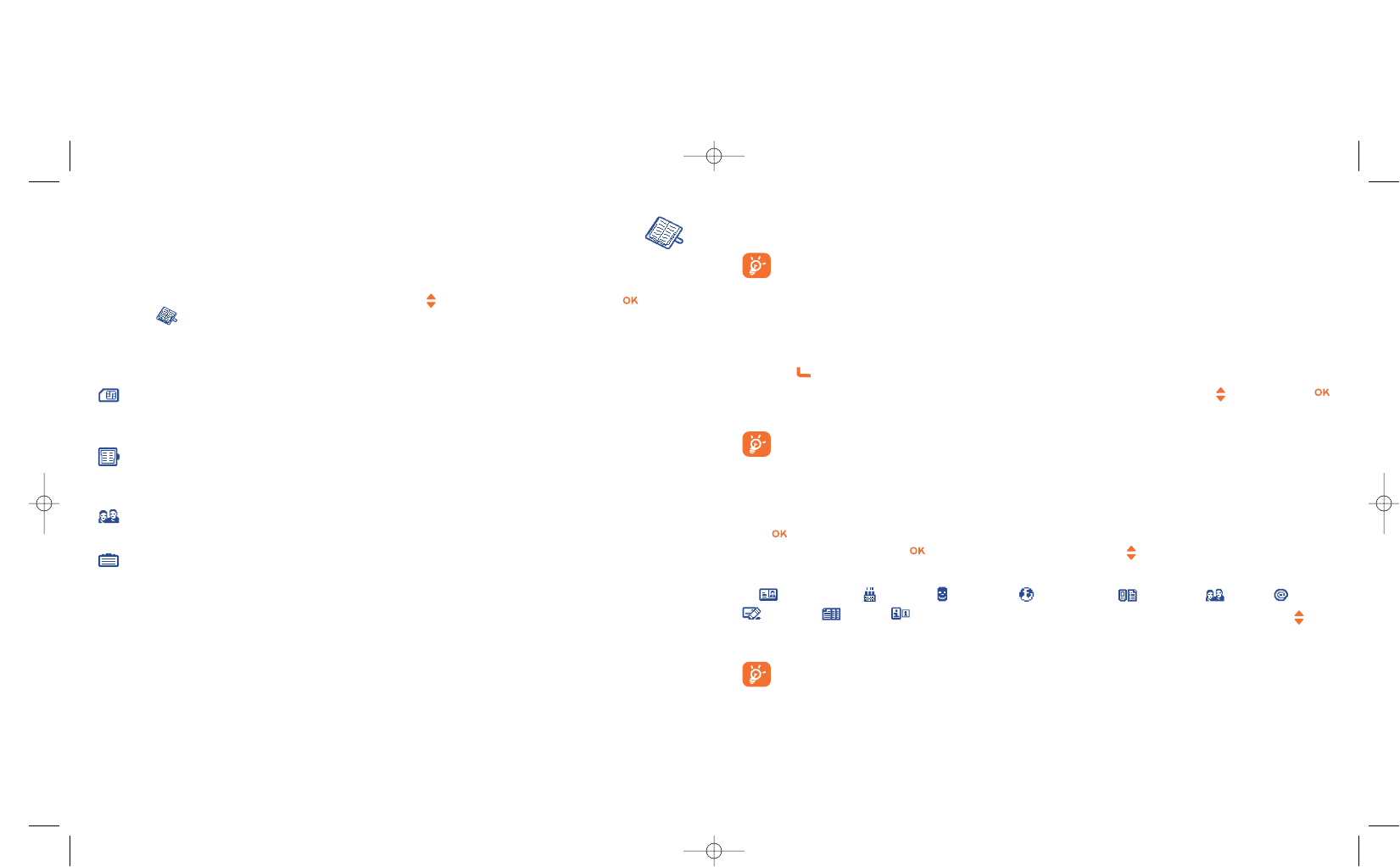
30
Searching for a name by its first letter
You can search for the person’s name by pressing the key associated with the first letter of his/her name.
For some languages that have a specific entry mode, you should use the “Search name” option.
Read a contact file
Select a name from your directory, choose “Options” and select “View”.
Making the call
Press the key when the name is selected. If several numbers are associated with the name to be called,
you must first choose the number from the list (Mobile, Home, Office, etc.) using the key. Press the
key to make the call.
Information in the directory and the diary may be sent to and received from a computer using the
Alcatel PC suite (see page 95).
6.2 Creating a contact
Select the directory in which you wish to create a file, press the right softkey, select “Create contact”
then . You can save the data you have entered at any time by pressing the left softkey. Go to the
following field by pressing the key or by using the navigation key .
When you create a new contact in the product directory, at least one of the following fields must be filled
in: Identity card, Birthday, Nickname, URL address Numbers, Image, E-mail,
Address, Notes, Perso. Info. 1...4. You can move from one field to another using the key.
When the field “Birthday” is filled in, an alarm is automatically created in the Diary.
With the PC suite, you can transfer all your contacts from and/or to a computer. You can also use
the infrared feature to transfer your contacts one by one to a personal computer or another
mobile phone equipped with an infrared device.
6Directory ................................................
6.1 Consulting your directory
To access the directory from the main screen, press the key (1) downwards or press the key and
select the icon from the menu.
You can customise the keypad by assigning quick access keys (see page 54).
You have 4 directories:
SIM directory:
The SIM card’s capacity depends on your operator. It is possible neither to assign more than one
number to a name nor to access advanced functionalities.
General directory:
Contains all files created. The SIM card files are not created automatically in the general directory,
but they can be copied to it.
Personal directory:
You can store your personal contacts in this directory (relatives, friends, etc.).
Professional directory:
You can store your professional contacts in this directory (companies, etc.).
In addition to the directories already provided, you can create your own directories (see page 32).
29
(1) Depending on your network operator.
CTH3_UM_FCC_15-03-05 15/03/05 9:18 Page 29
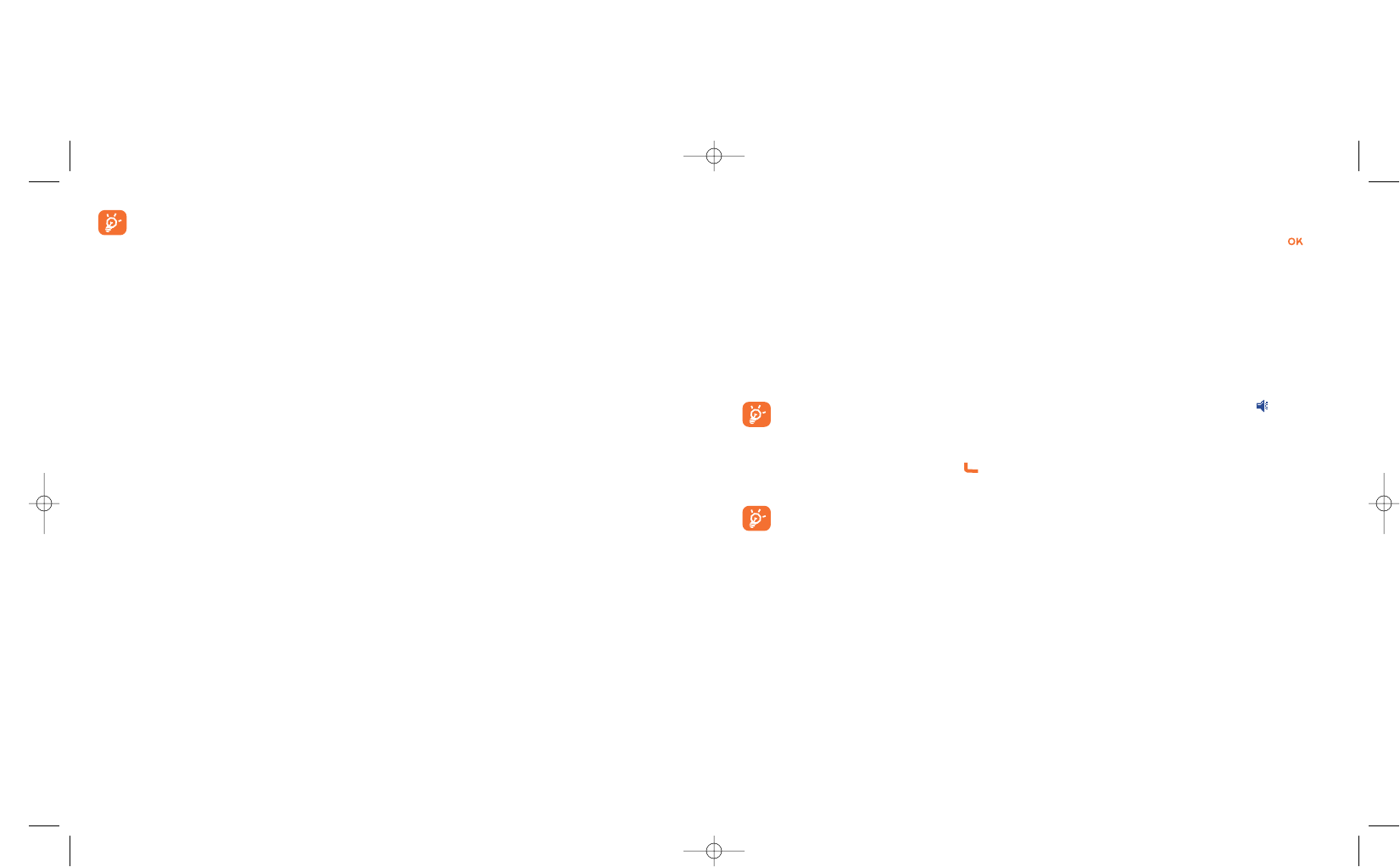
6.4 Creating a new directory
From the product directory, press the right softkey and select “Create dir.”, confirm using the key,
then name your new directory. Only directories you created can be deleted with the “Delete dir.” option.
6.5 Voice tag
Voice tag allows you to place your call by pronouncing the party’s name without using your directory.
Select a file from the product directory and confirm with the right softkey. Then select “Voice tag” and
confirm once again. Three different beeps will signal the start of recording, its failure or its success. After
recording, you can “Listen to”, “Replace” or “Delete” a recorded voice tag command.
The files for which a voice tag command has been recorded are indicated by the icon. The
number of names accessible through voice tag is limited. This feature can be used in all directories
except the SIM card directory.
Activate voice tag by holding down the key from the main screen, then follow the instructions on the
screen.
When your phone is closed with the headset plugged in, hold down the headset key to activate
the voice tag. Talk and the call will be automatically placed.
32
If you use your phone abroad, store the numbers in your directories in international format “+”
followed by the country code (see page 16).
6.3 Available options
From the list of names in your directories, you can access the following options via the right softkey:
View •View a complete file: name, address, e-mail, etc.
Create contact •Create a file (name, numbers, address, e-mail, etc.) in the desired directory.
Write message •Send an SMS, MMS or Vox MMS to a contact from the directory.
Modify •Modify the contents of a file.
Image •Assign a video/photo/image to the current file by selecting it in the album or by
taking/recording it (1).
Delete •Delete the selected file.
Classify file •Move a file from one directory to another.
Dir. ringtone •Assign a melody to the current directory.
Create dir. •Create your own directory.
Empty dir. •Empty the contents of a directory.
Delete dir. •This directory and its files will disappear completely (created directory only).
Copy all-> •Copy the whole directory to the SIM or telephone directory in one go if there
SIM/Phone is sufficient memory.
Voice tag •Record a voice tag command (1).
Send •Exchange data via infrared (see page 67) or Multimedia/MMS.
Tips&Tricks •Get information and tricks about the current menu function.
31
(1) Not valid for the SIM directory.
CTH3_UM_FCC_15-03-05 15/03/05 9:18 Page 31

7Messages ................................................
From your telephone, you can read, write, send and receive short “Text/SMS” messages and
“Multimedia/MMS” and share them with other mobiles (1).
Multimedia messages are messages whereby you can send video clips, images, photos, animations, sounds,
voice messages (or Vox MMS: simplified MMS that allows you to send a voice memo as a message),
appointments (V.CAL) or directory files (V.CARD) to other compatible mobiles and e-mail addresses.
The multimedia MMS function can only be used if the service is proposed by your operator, if your
contract includes the MMS option and if all the parameters for sending MMS have been entered
(see page 47).
To access the messages from the main screen, press the top of the key (2) or press the key, select
“Messages” with the navigation key and confirm with the key.
The following list is displayed:
- Create message
- Inbox
- Outbox
- Voicemail
- Templates
- Parameters
- Memory
- Delete
- Tips&tricks
34
(1) Check with your network operator for the availability of the MMS service.
(2) Depending on your network operator.
6.6 Assigning a ringtone to a directory
Select a file from the product directory, press the right softkey and select “Dir. Ringtone”.
When you receive a call from a contact classified in the product directory, the ringtone will be the one
assigned to this directory.
6.7 Assigning an image, an animation or a video to a file
Select a file from the product directory, press the right softkey and select “Image”.
It is possible to assign either an image or a video but not both to the same contact. You can also take a
picture or record a new video. When you receive a call, the picture, animation or video clip that you have
chosen will be displayed on the screen.
6.8 Privacy
Your directory data can be protected (see option “Privacy” page 56).
33
CTH3_UM_FCC_15-03-05 15/03/05 9:18 Page 33

•“Deferred”reception: you will receive a notification with the name and number of the sender and the
title of the message if it has been filled in. You can then download the MMS at any time in order to read
it (1). You can also delete it without reading it; in this case the sender of the MMS will be informed that it
has been rejected.
•“Restricted” reception: same behavior as “Deferred” mode but the notification will be announced
only by the icon.
You can receive video clips, photos, images, or sounds by MMS. These MMS are automatically stored in the
memory of your telephone. If you select “Options/Save items” you can save the video clips, images or
sounds or all of them (in this case, save the first item displayed, then select the “Next” option to save the
second item, and so on). They are all saved in the multimedia album.
7.1.3 Options while receiving or viewing messages in Inbox/Outbox
Generally, the common following options are proposed:
Delete •Delete the message.
Reply •Reply by SMS, MMS or by Vox MMS.
Forward •Forward the message to other people.
Archive •Save your message in the “Archived” folder (product memory).
Sort by date/size •Sort the read messages by date or by size: by date is the default sorting.
36
When viewing the list of your messages, you will find the following status icons, depending on:
- the type of message: SMS message, MMS message, MMS notification, MMS sending in
progress, MMS message with a sound, MMS with video clip, MMS with copyright elements
which cannot be forwarded.
- Storage: messages stored on your SIM card (SMS only), messages stored in the phone’s
memory (MMS notifications).
7.1 Receiving and reading messages
When your phone is closed, a large icon will be shown on the middle of the external display to alert
you of one or more incoming messages.
7.1.1 SMS
In the main display, a line with the number of new and unread incoming messages appears on the screen.
Select this line and press the key to read it directly from the main screen. To modify or deactivate the
audible signal, see page 49.
7.1.2 MMS
You have three ways of managing the reception of MMS: immediate, deferred or restricted reception. From
“Parameters/MMS parameters”, confirm your choice in the “Mode:” option (see page 47).
•“Immediate” reception: when in idle mode, the icon will indicate that a new MMS is being
downloaded. When the MMS is completely received, the message “New message!” appears, a beep
sounds, the icon shows up, a line with the number of messages appears on the screen. Select this line
and press to select and open the MMS.
35
(1) If connected to a network.
CTH3_UM_FCC_15-03-05 15/03/05 9:18 Page 35

- when reading an MMS:
Restart •View the message again.
With sound/ •View your MMS with or without sound.
Without sound
Save items (1) •Save video clips, images, sounds received in MMS current page.
In addition:
- If the MMS includes a WAP address, an e-mail address, or a telephone number, you have two possibilities:
select the “Options”, to save and/or access the link displayed (launch WAP link, send e-mail, or call
number displayed).
- If the MMS contains several pages, it will scroll automatically. To launch the viewing again, select the
option “Restart” or use the navigation key .
7.2 Creating and sending messages
7.2.1 Creating SMS
From the main menu, select “Messages/Create Message”, select “Text/SMS” and press . You can
also modify a predefined message selecting “Templates”.
Customise your messages adding pictures, sounds or mood icons proposed in your telephone: while writing
a message select the following options using the key:
38
(1) - For one object press to save.
- For several objects press “Options”, choose the objects one by one using the option “Next”, and
press to save.
37
The following options depend on the context (receiving a message, reading an MMS or an SMS in the Inbox
or Outbox):
SMS additional options:
Save picture •Save a picture contained in the message.
Save animation •Save an animation contained in the message.
Save melody •Save a melody contained in the message.
Save template •Save the message as a predefined message.
Save number •Save a number or an e-mail address contained in the message.
Launch WAP •Go to the WAP address contained in the message.
Zoom •Activate or deactivate the zoom.
MMS additional options:
- when selecting an MMS in the inbox/outbox list (1):
Open/Retrieve •Read the selected message (“Retrieve” if the deferred mode has been selected).
Details •Go to MMS details: local date, title, size, class, priority, mailing list, ack. of receipt.
Reply all •Reply to all MMS recipients.
Save no/e-mail •Save the senders’ number or e-mail address in your directory.
(1) Options available according to the reception mode chosen.
CTH3_UM_FCC_15-03-05 15/03/05 9:18 Page 37
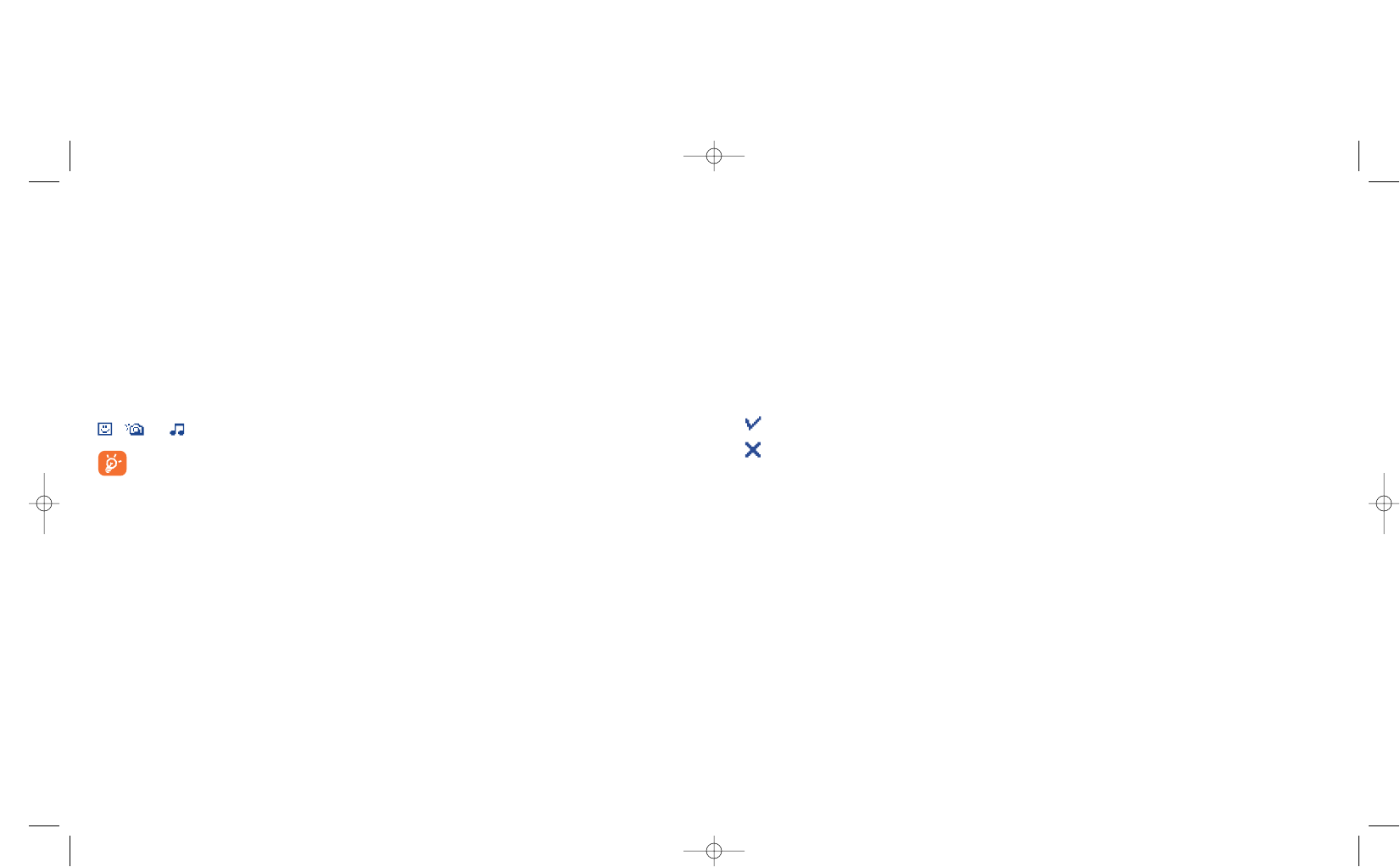
Options for sending your message
Directory •To a person or e-mail address whose contact is stored in one of your directories.
My Favourite •To your favourite contact.
Dial •To one person by entering the number manually.
Several recipients •To different people by manually entering the numbers or selecting them from the
directory.
Distribution list •To a group of people that you have pre-set in the sending parameters
(“Distribution list” option).
If the acknowledgement of receipt (“Rpt:”) is activated in “Parameters/SMS parameters”, (see page 46),
when you consult your sent messages, the following symbols will show the following:
Msg. received: message sent and acknowledgment received.
Not received: message sent and waiting for a “Delivery report” or message not received: you
should send the message again.
Other options are available if you choose the predictive entry mode (see page 44).
4039
Send to •Send the message.
Add mood •Add a mood icon to your message.
Add image •Add an icon to your message.
Add melody •Add a sound to your message.
Add bookmark •Add a web site to your message.
Symbols •Go to the symbols table.
Predictive •Switch to the predictive mode.
Preview •View your message.
Save •Save the message and send it later.
Select “Preview” to see the whole message: the icons, sounds and mood icons are represented by the
, or symbol. You can also download new sounds and images over WAP (see page 95).
A message of more than 160 characters, or a message containing icons, sounds, or mood icons
may be billed as more than one message. Check with your operator.
The person receiving the message must be equipped with an EMS, compatible mobile phone in
order to display the objects or listen to the sounds in your message.
CTH3_UM_FCC_15-03-05 15/03/05 9:18 Page 39

42
Add video •Add a video from the “Video album” function or create it with the “Record
video” option.
Add sound •Add a sound from the “My sounds” function, or a voice message.
Add text •Write your text.
Add title •Give a title to your MMS.
Add bookmark •Insert a bookmark (URL) from the list of your favourite sites (see page 71).
Text options •-“Directory”: insert a contact number.
-“Symbols”: insert a symbol.
-“Predictive”: switch between normal and predictive mode.
Replace •Change an item in your MMS.
Remove •Remove an item in your MMS.
Add page •Add a page to your MMS.
Previous page •Go to the previous page of your MMS.
Next page •Go to the next page of your MMS.
Delete page •Delete the current page.
Attachments •Add a Vcard or Vcal.
Preview •Preview the MMS you created.
Save •Save your message if you do not want to send it immediately.
7.2.2 Creating MMS
From the main menu, select “Messages/Create message/Multimedia MMS” and press . By default,
you are in edit mode.
Your MMS may contain several pages (maximum memory allocated: usually 50 KB or 100 KB depending on
the model and the operator) ; as you create the MMS you will be informed of the memory used (for all
pages).
With the option “My e-mail”, you can send images, video clips, sounds, ... to your computer.
If the acknowledgment of receipt (“Rpt:”) is activated in “Parameters/MMS Parameters”, you can
consult it in the option “Details” when selecting a message (see page 47).
You may also attach special files to your MMS such as: a contact from your directory (Vcard), or an
appointment from your diary (Vcal). They will be displayed in a separate page (select option
“Attachments”).
Depending on whether your MMS is empty or not, with no file or at least one file attached, you will be given
the following options:
Send to one •Send to one recipient from your “Directory” or “Dial” the number or e-mail or
select “My Favourite” or “My e-mail”.
Send->several •Send to several persons by dialling the numbers (“Dial”), or selecting the
numbers, or the group (“Add group”) from the “Directory”.
Add image •Add a picture or an animation from the “Image album” function, or create it
directly from the “Take a picture” function.
41
CTH3_UM_FCC_15-03-05 15/03/05 9:18 Page 41

(1) Contact your network operator to check service availability.
(2) This Vox MMS being a normal MMS which contains an AMR type sound, you can only listen to it with
an AMR IETF compatible phone or a computer equipped with an adequate sound decoder.
44
If the message is not sent, the mobile will try to re-send it automatically (1). The icon is displayed on the
screen and in the “Outbox/Unsent” folder, indicating the automatic sending procedure is activated. If it
fails completely, you will be notified by a message and the icon in your “Unsent” folder indicates that
the MMS could not be sent. Select it and press “Options” to send it again, modify it or delete it.
7.2.3 Creating Vox MMS (Voice memo)
From the main menu, select “Messages/Create message/Voice/Vox MMS”. This function allows you to
send a message quickly without having to write. The recipient is not disturbed and simply receives a normal
MMS (2). You can reply to any message using a “Voice/Vox MMS”.
7.3 Speed writing system
The “Predictive” mode speeds up writing of your SMS or MMS. When you want to write a message, press
the “Options” softkey, select “Predictive” for SMS, or select “Text Options” then “Predictive” for
MMS and begin to type ; for instance for “hello” type on the following keys , , , ,
once. The letter or word displayed may not always correspond to the desired one but do not pay attention,
continue typing and the system will make better suggestions as you continue to input letters.
With the options “Add image” or “Add video”, you can also access the photo or video function or album
directly while you are writing a Multimedia Message (MMS).
You have two ways to insert a video or photo in an MMS:
•Either by adding an existing video-clip to your MMS taken from the video album:
when you are in the “Messages” menu, select "Create message/Multimedia/MMS”, press the
key, select the “Options” softkey, then “Add video/Video album" or “Add image/Image album”
depending on the type of the media you want to insert and select the file (the first image of the video
selected is displayed in the MMS slide to notify that the video is correctly attached to the message).
•Or by recording directly a new video clip or by taking a new photo:
Shoot: Choose “Add image”, press the key and then select “Take a picture”.
Video: Choose "Add video", press the key and then select "Record video". When included in an
MMS slide, the video is automatically saved in the default folder of the Video Album.
If a video is inserted in a page, you can add text only; it is not possible to add another image, or a
sound to the same slide. A new page will be automatically created if you select “Add image”,
“Add sound” …
Reply to an MMS by sending an MMS, an SMS or a Vox MMS message. To send text only, it is advisable to
use an SMS.
To send your MMS later on (to add other items or photos for instance) save your MMS (“Save”) as a draft
stored in your “Outbox/Unsent” folder. Then select it and use the “Options” function to add or remove
items before sending it.
43
CTH3_UM_FCC_15-03-05 15/03/05 9:18 Page 43
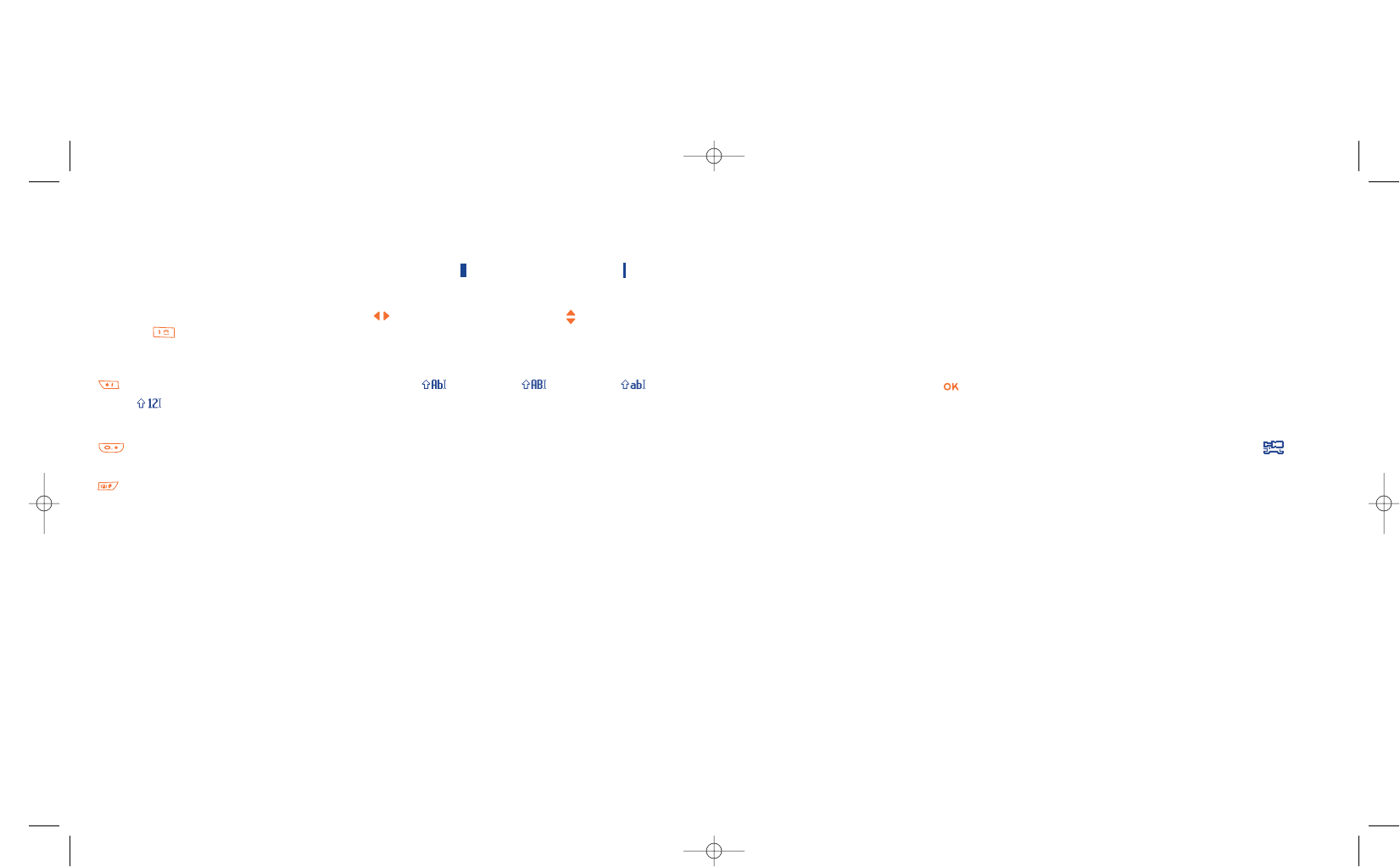
46
(1) Contact your network operator.
(2) Contact your operator for details to fill in these fields.
Confirm word •Confirm the selected word.
Other words •View other possible words.
Add word •Add a word to your personal dictionary.
Add numbers •Go to the digital mode.
Normal •Switch to the normal mode.
Languages •Use the dictionary in another language.
Save •Save the message.
You have a personal dictionary which allows you to add (1), modify or delete words. While writing a message,
you can add a word by pressing the key and by selecting “Add word”.
7.4 Parameters
From the main menu, select “Messages” and using the navigation key to the right, select the icon.
7.4.1 SMS Parameters
•Service centre (“SC:”) (2): phone number of your operator’s service centre (it may be provided
automatically).
•E-mail centre (“EC:”) (2): the number of the server for sending e-mails (it may be provided
automatically).
•Delivery report (“Rpt:”): request for acknowledgement of receipt for each message sent.
•Message validity (“Val:”): the time period during which attempts to send the message to the recipient
will be repeated in case of failure.
•Format (“Typ:”): format to be used for delivery of message to recipient (SMS, fax, etc.).
•Memory (“Mem:”): product or SIM (see page 47).
45
When in predictive mode, type the first letter:
- if it corresponds to a single word (for instance a), the letter will be displayed,
- if it does not exist as a single word (for instance h), the symbol “*” will be displayed.
The cursor shape varies depending on the input mode selected: in predictive input mode, in normal
mode.
To confirm a word and insert a space, press the key to the right or press the key downwards or
press the key.
Specific keys Normal mode / Predictive mode
Short keypress: Move between automatic capitals , upper case , lower case , digits
.
Long keypress: Switch between the normal and predictive mode.
Normal: Insert a “+”, “0” or “•”.
Predictive: View other words in the dictionary.
Normal: Display the symbols table.
Available options
In addition to the available options in the normal entry mode, you will also find the following choices:
CTH3_UM_FCC_15-03-05 15/03/05 9:18 Page 45

For information:
- Received SMSs are always in the SIM card,
- Received MMSs are always in the product.
You can always save your messages in the “Archive”. They will then be stored in the product.
7.4.4 Create a distribution file
In the “Parameters” folder, select “Distribution list”, confirm with the key, then name the group.
You can now enter the phone numbers for the members of your new distribution list.
7.4.5 My Favourite
Enter the number or email of your favourite contact. Then, when you want to send a message, select
“Send” and “My Favourite” directly without searching in the directory.
7.4.6 My e-mail
Enter your own e-mail address (if not entered yet under the option “My e-mail” of the “Call Log” menu)
to be able to send more easily images, pictures, sounds, ... by MMS to your PC.
7.5 Deleting messages
To delete all messages on your SIM card or in the product, select the icon and select the following
options:
-“Delete SIM msg”: delete all messages received and sent from the SIM.
-“Delete phone msg”: delete all messages stored in the phone’s memory.
Your SIM card’s capacity depends on your operator. The icon appears when the card is full.
To receive new SMS, delete some old ones.
4847
7.4.2 MMS Parameters
•MMS profiles (“Profile:”) (1): To set your MMS profile, follow the same procedure as for setting your
WAP connection (see page 71).
•Mode: choose between immediate or deferred reception for national network coverage, or between
immediate or restricted reception for international network coverage (see pages 35-36).
•Acknowledgement of receipt (“Rpt:”): request for acknowledgement of receipt for each message
sent.
•Message validity (“Val:”): the time period during which attempts to send the message to the recipient
will be repeated in case of failure.
•Memory (“Mem:”): to store automatically your sent messages.
•Timer: sets the speed at which the pages scroll through: the recipient will see the message at this speed.
•Filters: Anonymous MMS filtering: to receive or not anonymous messages
•Layout configuration: choose between display: image first then text or text then image.
7.4.3 Saving parameters
You can change the save parameters for your messages:
- Sent SMSs are stored by default in the product:
Select “SMS parameters” and “Mem:” to choose “SIM memory” or “Phone memory”, or “Not
saved”.
- Sent MMSs are stored by default in the product:
Select “MMS parameters” and “Mem:” to choose “Phone memory” or “Not saved”.
(1) Contact your operator for details to fill in these fields.
CTH3_UM_FCC_15-03-05 15/03/05 9:18 Page 47
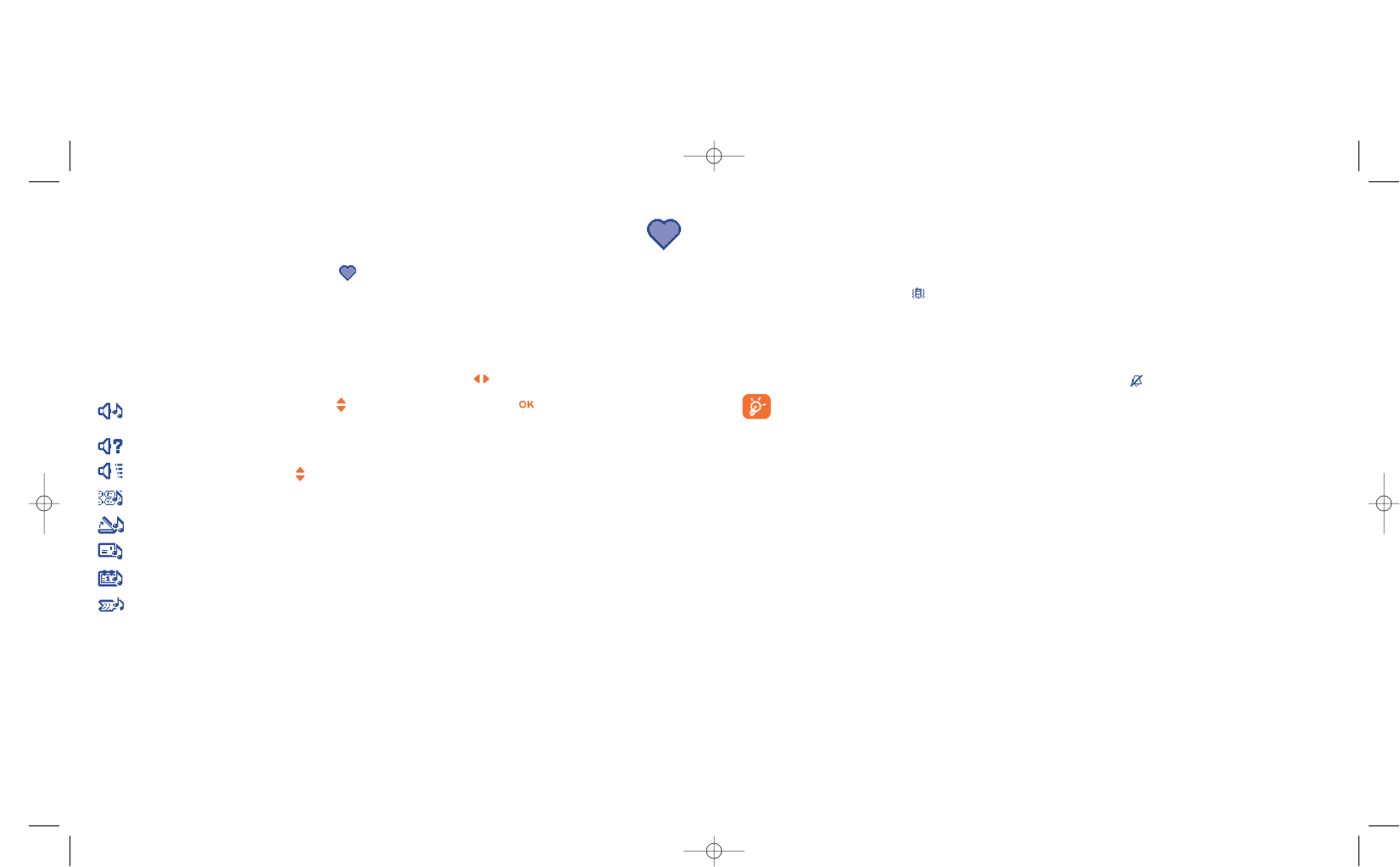
50
8.1.2 Mode
Normal •Normal ringtone (increasing volume).
Discreet •Normal ringtone (increasing volume) preceded by beeps.
Vibrate •Activate the vibrator and mute all sounds (ringtone, message beep, appointment).
The icon will be displayed.
Vibrate and Ring •Vibrator and the normal ringtone at the same time.
Vibrate then Ring •Vibrator followed by beeps then the normal ringtone (increasing volume).
Beep and vibrate •Warning beep followed by the vibrator.
Silence •No sound nor beep except for alarms. The icon will be displayed.
Some of these modes may be deactivated when using certain accessories (handsfree car kit, ...).
8.1.3 Surprise melody
At the top of the list of melodies, access the item “Surprise melody”; choose up to 20 melodies you want.
Then, each time you receive a call, one of the melodies you have chosen will be played at random.
8.2 Display
8.2.1 Main screen
The main screen is displayed after a short period of inactivity. If you receive an event (incoming call,
SMS/MMS, notifications, etc.) the icon, type and quantity of events will be displayed on your main screen
allowing you to consult them directly.
49
8My settings..............................................
From the main screen, select the icon menu and select the function of your choice in order to customise
your telephone.
8.1 Ringtones
8.1.1 Available functions
To modify the sound settings, select the different options using the key:
Select a melody in the list using the key then confirm by pressing .
You can also select in this list the random melody function called “Surprise melody” (see page 50).
Mode (normal, discreet, vibrator...).
Adjust the volume using the key.
Select the type of key beep.
Select a couple of sounds for the flip’s opening/closing.
Select a melody for a new incoming message.
Select a melody for a new appointment’s alarm.
Select the type of network beep (1).
(1) Contact your network operator.
CTH3_UM_FCC_15-03-05 15/03/05 9:18 Page 49

When using the telephone for the first time, a default Atmosphere is activated.
Even if you choose an Atmosphere, you can still modify the elements in it one by one. You can reactivate
an Atmosphere at any time.
The installation of the Atmosphere can be stopped and cancelled if you receive an incoming call or
if you press the key ; the previous choice of Atmosphere is kept.
8.2.1.4 On/Off screens (1)
You can customise your welcome message, animation, melody or image that appears when you switch on
your telephone.
You can also customise your OFF screen with an image or animation.
8.2.1.5 Zoom (2)
Two character sizes are available for your telephone screen. Large characters are selected by default. If you
wish to display more information select “Zoom”.
8.2.1.6 Contrast
Set the contrast of your screen.
52
(1) Depending on the model.
(2) Depending on the language.
51
You can access the main functions directly from the main screen either with the navigation key or by
selecting the icons displayed on the screen (1).
By selecting the “Main screen” you can customise it by replacing the default image or animation displayed
on your telephone.
8.2.1.1 Screen saver
If you activate this option, the screen saver will be displayed a little while after the main screen. You can
choose a picture, an animation, a slideshow, or a videoclip as your screen saver.
In either case, Main screen or Screen saver, the eco-mode screen will appear after a little while:
only the battery and network levels and the time or an envelope (for incoming event) will be
displayed.
8.2.1.2 Colours
This function enables you to customise the graphic style and the colours of your telephone (menu screens,
input screens, etc.)
8.2.1.3 Atmospheres
The “Atmospheres” menu allows you to customise your telephone to suit your own taste. You can modify
seven customisable items at the same time. An atmosphere includes four visual items (ON/OFF/Main screen
image or animation, skins and colours) and three melodies (for incoming calls, notification of incoming
messages and the switching on of your phone).
(1) Depending on the operator.
CTH3_UM_FCC_15-03-05 15/03/05 9:18 Page 51

54
8.3 Clock
You can display two clocks (local and remote) at the same time.
Go first to the “Clock type” icon and select the “2 clocks” option. Then go back to the “Clock set
up”, select “Local clock”, choose a city and confirm. The automatic transition to daylight saving time is
activated. Repeat the same operation for the “Remote clock”.
Display format
You can display your clock in analogue or digital format and the date in the following formats:
day/month/year, month/day/year or year/month/day in digits or using the first three letters for the day and
month.
8.4 Customising the keys (1)
Access this feature by selecting “My settings” from the main menu, then “Keys”.
8.4.1 Operator/Personal key and softkeys (1)
These keys have predefined functions which vary from one model to another (operator services, games
access, or Games & Applications, ...). You can customise (1) them for long and short keypresses, giving them
the functions that you wish. For example, they can be used as a shortcut to access the Diary, to write a
message,...
(1) Depending on your network operator.
53
8.2.1.7 Menu display
Select a menu display by choosing from the three options proposed:
•“Icons”: one icon per screen with part of the previous and following icons are visible on either side.
•“Image”: one full-screen icon.
•“Board”: all the menu icons displayed on the screen.
8.2.2 External display
The external display of your phone indicates you of any events.
You can personalise the external phone display by setting:
Time and date
Time only Only the time is displayed (with the status bar).
Date + time Time and date are displayed as follows: dd/mm hh:mm.
Screensaver When the phone is closed, a screensaver will be displayed after a period of inactivity.
None No screensaver.
Animation A predefined animation will be played.
Clock The clock will be displayed in large format without the status bar.
CTH3_UM_FCC_15-03-05 15/03/05 9:18 Page 53

56
8.5.3 Languages (1)
Display language for messages (select using ). The “Automatic” option selects the language according to
the home network (if available).
8.5.4 Dictionary
You have a dictionary to which you can add your own words in addition to those suggested by the predictive
input system. When you consult your dictionary, you can add, modify or erase words by using the
“Options” softkey.
8.5.5 Input mode (2)
In addition to the specific character table for Arabic, Cyrillic, Chinese, other data input modes are also
available in your telephone. This feature allows you to write short messages and enter names into your
directory.
8.5.6 Extensions display
This function allows you to choose whether to display the extensions of your photos, videos, sounds, files
of your Album.
8.5.7 WAP access features
(See page 73).
8.5.8 Privacy
Select “Activate” in this option in order to protect your diary or directory data. This option is useful if you
use PC synchronisation.
(1) Contact your network operator to check service availability.
(2) Depending on the language.
55
8.4.2 Keypad
By customising your keys, you can call someone or access a function directly from the main screen.
To programme a key on your keypad, select “Keypad” and choose the key that you wish to programme.
Then select:
-“Contact list” activate this option if you want to access directly, in the directory, to the contact which
first letter corresponds to the first letter of the key for instance key for “PETERSON John”.
-“Custom keys”: activate this option to access the numbers or functions that you have already
programmed. If you want to change them, press the “Options” softkey, select “Modify” and choose the
first key you want to program.
You will then be able to access these shortcuts from the main menu in “My Shortcuts”.
8.5 More settings...
8.5.1 Keypad lock
Activate/deactivate the keypad lock. The keypad (including the side keys) is automatically locked when you
close the flip.
If the telephone is plugged in using a car kit accessory or the charger, it will be unlocked
automatically. The keypad turns temporarily unlocked when you receive an incoming message/call
or when the programmed alarm rings.
8.5.2 Flip answer
Activate/deactivate the call answering by unfolding your phone.
CTH3_UM_FCC_15-03-05 15/03/05 9:18 Page 55

8.5.10 Network
SMS CB (1) Messages broadcast over the network (weather forecast, traffic conditions, etc.) are
automatically displayed on the main screen.
•CB list List of codes for messages to be displayed.
•Reception Depending on the option selected, the phone displays messages broadcast over the
network.
Partial The phone receives messages intermittently and displays them according to your list (see
“CB list” option).
Complete The phone continually receives messages and displays them according to your list (see
“CB list” option).
None The phone does not receive any messages.
Search Search for a network connection.
•Available List of networks available in your radio environment.
•Mode Depending on the option selected, the network search mode is:
Automatic The first network searched for is the network you used last.
Manual The choice of the connection network is left up to the user.
•Preferred list List of networks to which you wish to be connected in order of priority (update this list
using ).
Band Select the frequency band.
58
(1) Contact your network operator to check service availability.
57
8.5.9 Security
PIN code (1) The SIM card protection code is requested each time the phone is switched on if this
code is activated.
Activate/ Activate/deactivate this code.
Deactivate
Change Update code (between 4 and 8 digits).
PIN 2 code (1) Protection code for certain SIM card features (Billing/Cost/FDN, etc.) will be requested
if accessed while the code is activated.
Change Update code (between 4 and 8 digits).
Network Password requested for network “Call Barring” options.
code (1)
Menu code A protection code for certain MENU options (services, settings, language) will be
requested if accessed while the code is activated.
Activate/ Activate (or cancel) this code.
Deactivate
Change Update code (between 4 and 8 digits).
Telephone A telephone protection code will be requested each time the phone is switched on, if
code this code is activated.
Activate/ Activate (or cancel) this code.
Deactivate
Change Update code (between 4 and 8 digits).
(1) Contact your network operator.
CTH3_UM_FCC_15-03-05 15/03/05 9:18 Page 57

60
9My Shortcuts ..........................................
Access your own shortcuts already programmed.
To programme or modify your shortcuts, access the “My shortcuts” menu. Scroll the list and select the
corresponding item by pressing the key. Then you will be able to assign it to a function, a telephone
number or a WAP bookmark.
8.5.11 Accessories
Headset
A predefined melody will be played if the ringtone you selected is not an .amr file.
Headset pick up
•Key By pressing the key or the headset key.
•Automatic Automatically without any keypress, after approximately 2 ringtones (this option is
operational only if your mobile phone is connected to an audio kit or handsfree kit).
•Any key By pressing any key (except the side keys).
Audio mode Set the headset to ring, or both the telephone and headset.
Car kit
Pickup Choose the pick up mode: key, automatic or any key.
Melodies A default melody is assigned as the ringtone of your phone when connected to the car
kit. You can select a new one in a predefined list.
59
CTH3_UM_FCC_15-03-05 15/03/05 9:18 Page 59
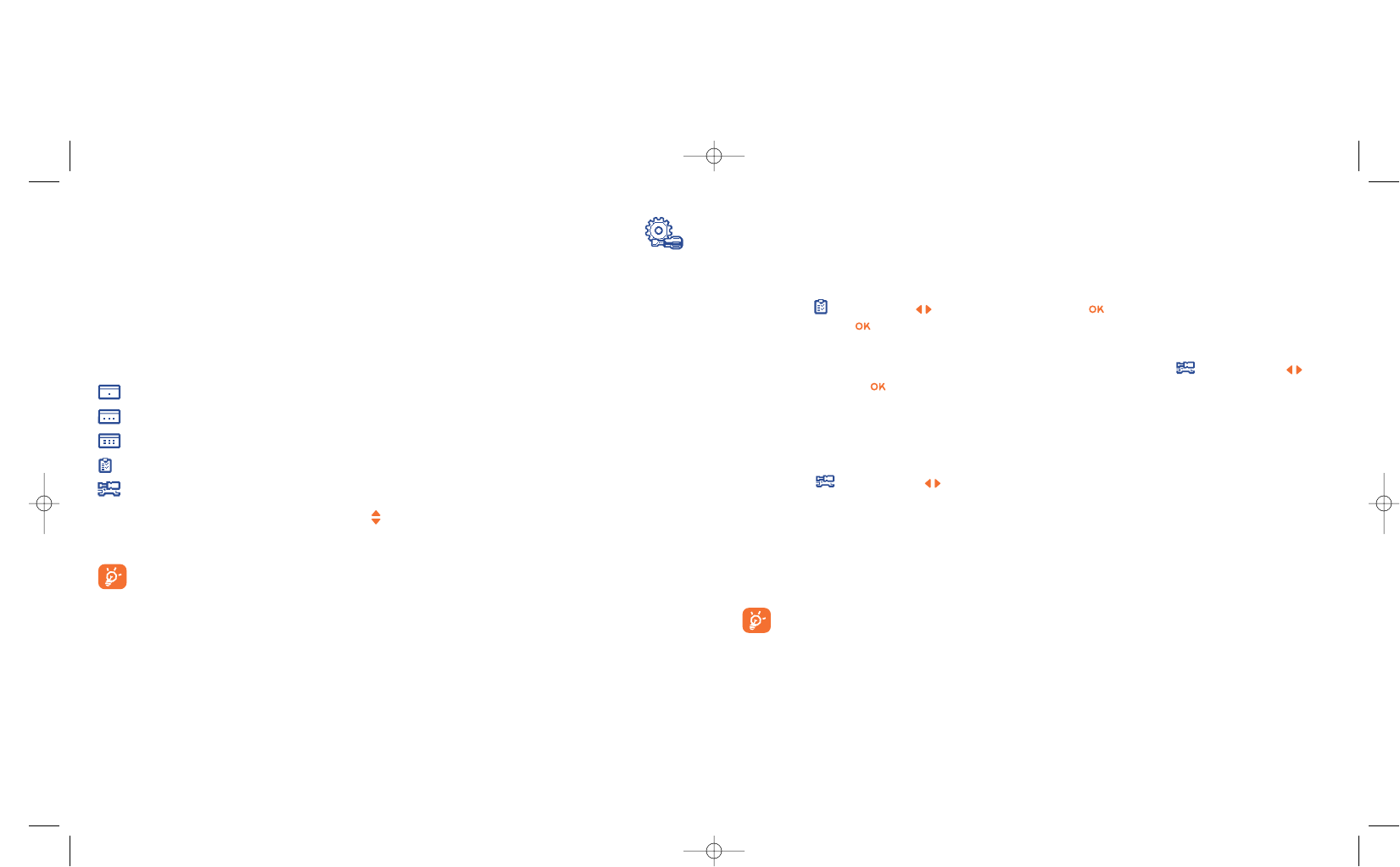
Creating an appointment and programming an alarm
When you create an appointment (“Create” option), you can also set an alarm. You can set the desired
alarm activation time to coincide with your appointment time.
Creating a task
Scroll to the icon using the key, and confirm using the key. Select “Select type”, then confirm
once again using the key and enter the type of task to be performed (“to do” or call appointment), then
enter the purpose.
This list can be arranged by deadline or by priority. To do this, scroll to the icon using the key,
then confirm using the key.
You can set an alarm for a task for which you have set a due date. This alarm will sound on the chosen day
at the time that you entered.
Configure the diary
Scroll to the icon using the key, to access the following options:
Alarm •Set a default time for the alarm to sound before the scheduled appointment.
Diary •Programme the start time for your day, your first day of the week and your first
week of the year.
“To Do” •Sort your tasks by priority or by due date.
Delete •Delete all tasks or diary items or only those items that have expired.
Privacy:
The data of your diary can be protected (see option “Privacy” page 56).
62
10 Tools ........................................................
10.1 Diary
Your phone has a sophisticated diary that will help you to manage your daily schedule. You can also save
“To D o ” lists.
Consulting your diary
Three views are possible. You must first choose the appropriate icon:
Daily view
Weekly view
Monthly view
“To D o ” list.
Parameters
You can scroll through the dates by pressing the key.
According to the view you can read, create, modify or send an item.
Information in the directory and the diary may be shared with a computer using the Alcatel PC
suite (see page 95).
61
CTH3_UM_FCC_15-03-05 15/03/05 9:18 Page 61
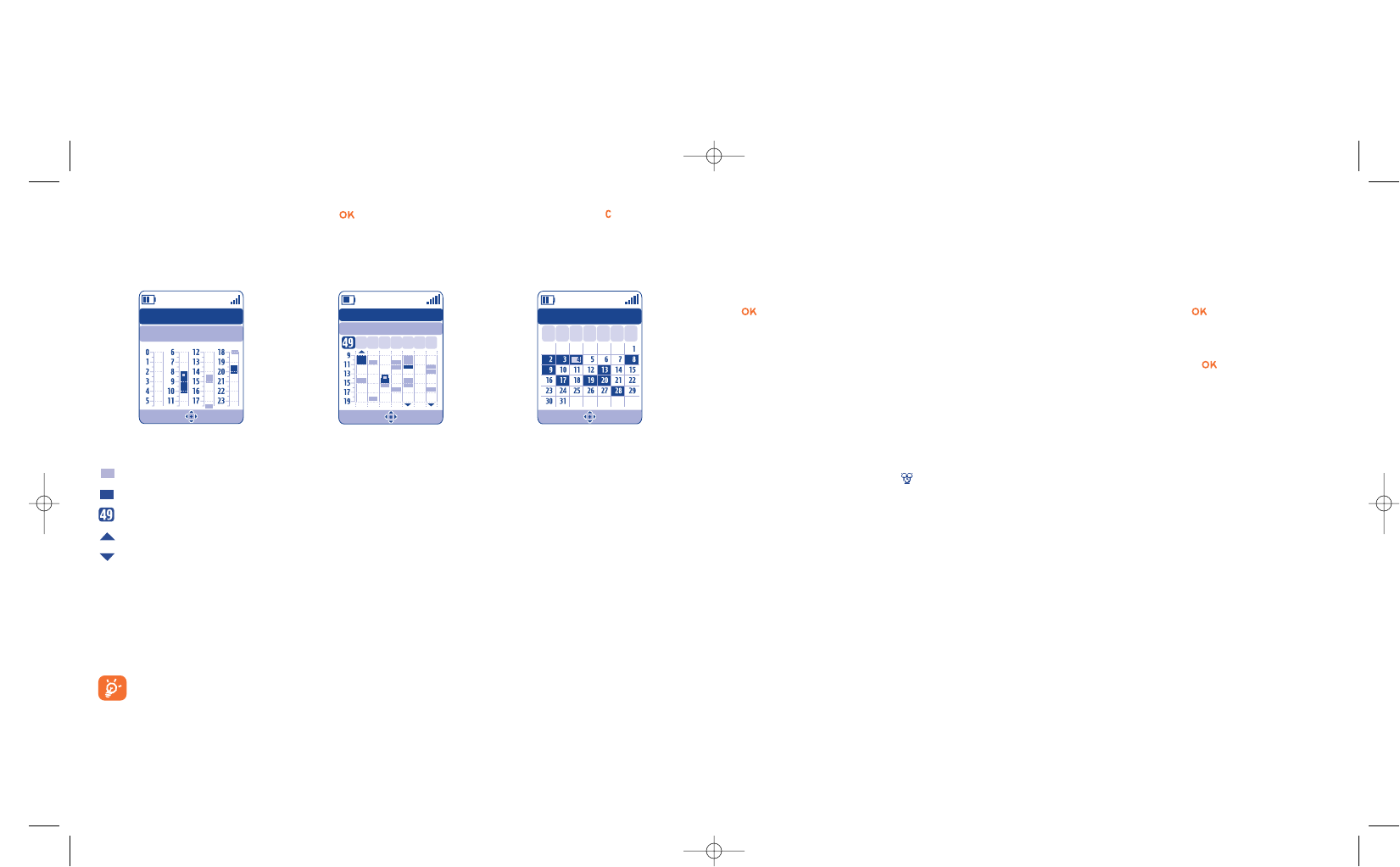
64
10.2 Alarms
Access this feature by selecting “Tools” from the main menu, then “Alarms”.
Alarm clock
First set the alarm frequency (daily or only once), then enter the time and date and confirm by pressing the
key. You can also enter the purpose of the alarm and then confirm with the key.
Timer
Set the amount of time desired before the alarm is to sound and confirm with the key.
Alarm settings
Snooze The alarm will repeat at regular intervals.
Volume Adjust the volume of the specific melody played for the alarm.
Ringtone Select the melody to be played.
When the alarm is set, the icon is displayed on the main screen. The alarm will sound whether the
handset is switched on or off and can be shut off by pressing any key or by opening the flip.
In this case, the opening of the flip will stop the ringing and take you directly to the alarm menu for a few
seconds before going back to the previous screen.
Daily view Weekly view Monthly view
63
Activate or deactivate a setting by pressing . Exit the configuration function by pressing .
More about your diary
Graphic view
A single appointment recorded.
Two or more appointments recorded during this time slot.
Week number.
An appointment was recorded prior to this time slot.
An appointment was recorded after this time slot.
Monthly view
Blue background Meeting scheduled
White background No meeting scheduled
In the various views, the current day, week and month flash.
The birthday alarm will ring at the time indicated in “Parameters/Diary/First hour day”. Modify
it to meet your wish.
Wed. 4th December 02
2 Events
Wed. 4th December 02
2 Events
December 2002
TMWFTSS TMWFTSS
Create Options Create Options Create Options
CTH3_UM_FCC_15-03-05 15/03/05 9:18 Page 63

10.5 Memory
Access this feature by selecting “Tools” from the main menu, then “Memory”.
View available memory space.
Your telephone’s memory is shared between several functions: directory, diary, messages, voice messages,
voice tag, images and melodies, games and applications, video clips. For example, if you use a lot of memory
for your voice memos, you will have less memory available for the directory.
Do not forget to delete large items such as voice memos, MMS, images, photos, recorded sounds,
applications, video clips..., in order to free up memory space, otherwise the performance of your
terminal may be affected. You can also delete certain items included in your telephone on
purchase.
10.6 Voice memo
Access this feature by selecting “Tools” from the main menu, then “Voice Memo”.
The voice memo feature enables you to record personal messages. To record a voice memo, select “Voice
memo”, then “Record”, and begin speaking after the beep. Once the voice memo has been created, you
can access the following options:
Listen to •Listen to a recorded voice memo.
Send •Send your memo by MMS or infrared.
Handsfree/Discreet •Switch between handsfree and discreet mode.
Title •Modify the name of the memo.
Memo->album •Copy the memo to your sound album (to send it by MMS or use it as a ringtone).
Delete •Delete the selected memo.
When the telephone is closed, you can record a voice memo by pressing and holding down one
of the two side keys.
6665
10.3 Converter
Access this feature by selecting “Tools” from the main menu, then “Converter”.
The currency converter allows you to:
•Convert a currency into euros and vice versa (1).
•Convert a sum of money into another currency (e.g. dollars to pounds).
For a conversion into euros, you can modify the default currency by selecting “Set up”.
If converting between international currencies, both currencies must be selected. You must also enter the
appropriate exchange rate.
An exchange rate value is pre-set for each currency. You can change this value by selecting “Set up”.
From the main screen, enter the amount in euros to be converted into the programmed currency,
then press the key and select “Converter”.
10.4 Calculator
Access this feature by selecting “Tools” from the main menu, then “Calculator”.
Enter a number and confirm with the key, then select the type of operation to be
performed using the key and confirm again.
Enter the second number and press .
Select the “=” sign to display the result.
To return to the main screen, press the key (long keypress).
Calculator
(1) For the former European national currencies, the currency converter uses the final Euro conversion
rates set on 31/12/1998, which are used in accordance with official conversion rules.
CTH3_UM_FCC_15-03-05 15/03/05 9:18 Page 65

68
10.9 Tone composer
Access this feature by selecting “Tools” from the main menu, then “Tone composer”.
10.9.1 Compose
Select “Compose” then use the keypad as shown below:
Go to the options
Delete a note
Key 1 to 7: basic notes of an octave (C, D, E, F, G, A, B)
Change the length of a note or a pause
Change the octave
Add a pause
Add a sharp
10.9.2 Record
Select “Record” to record a sound of your own.
In both cases, you can use a sound as a melody. If you want to listen to a sound (composed or recorded),
select the desired one and press the “Options” softkey.
(1) If you use infrared often, we advise that you set a quick access to it from the keypad (see page 54).
67
10.7 Infrared
Access this feature by selecting “Tools” from the main menu, then “Infrared”.
Your phone’s infrared feature allows you to exchange contacts, diary data, images, videos, melodies via an
infrared link with an other mobile or a PC. The infrared port is located on the top of your telephone.
Sending data
To send data, select the directory file, then select the “Send” option. It is not necessary to activate the
infrared feature before sending.
Receiving data
To receive data, you must activate the infrared feature. A message will advise you of the arrival of data; you
then save the data by pressing the key or reject it using the key.
Once you have selected the option, the icon appears on your screen. Infrared will be deactivated
automatically after a short while (1). The connection will cut off if you have an incoming call. You can receive
up to five calling cards (V.card) or appointments (V.cal) at the same time.
10.8 Alarms list
Access this feature by selecting “Tools” from the main menu, then “Alarms list”.
You can view all the alarms that you have set. The icon will appear on your main screen if the alarm
clock or the timer has been set, or if the alarm is set for the current day or the following day.
CTH3_UM_FCC_15-03-05 15/03/05 9:18 Page 67
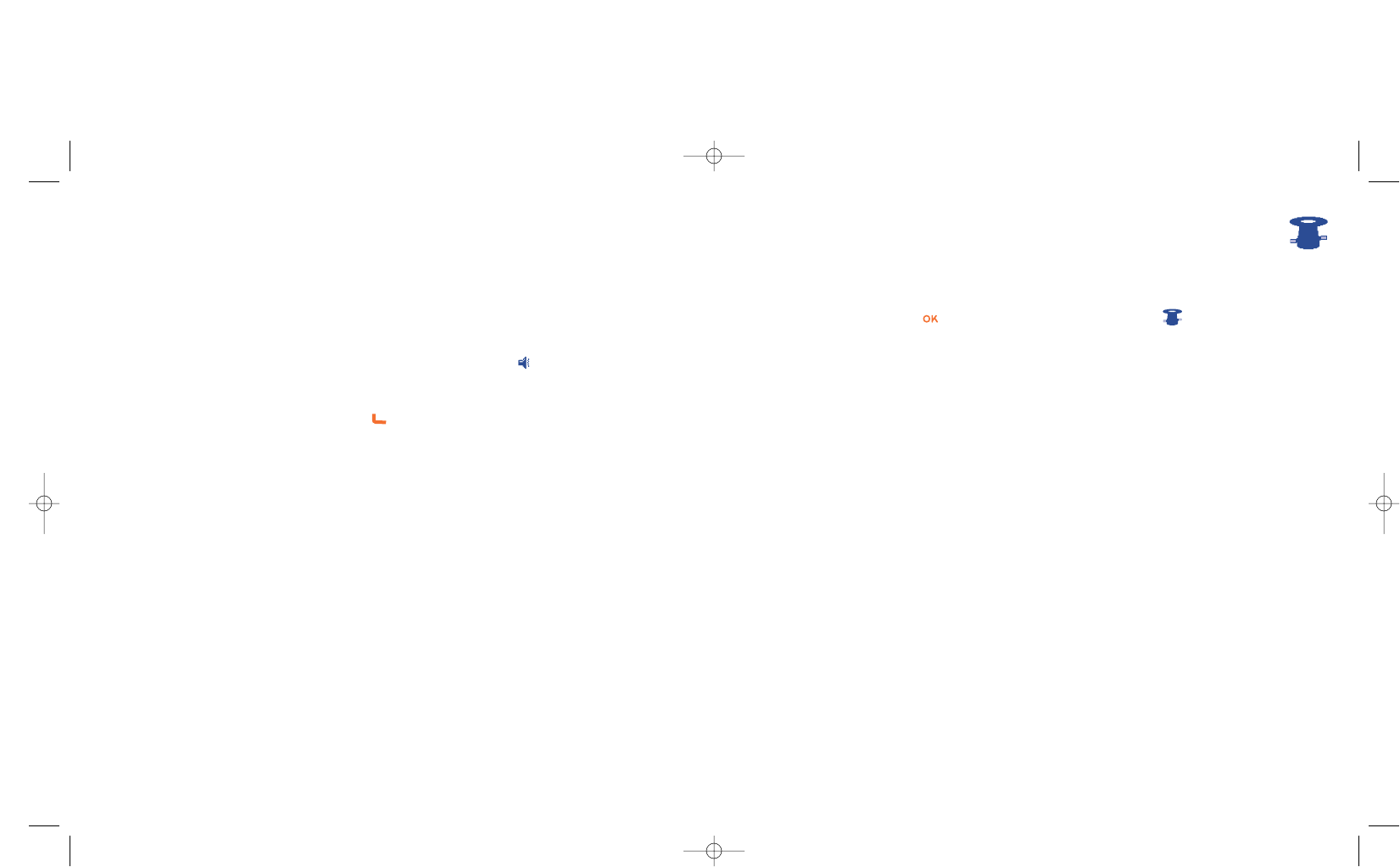
11 Tips & tricks ..........................................
This feature gives you a quick description of your phone’s main functions and provides handy hints to
optimize the way you use it.
From the main screen, press the key to access the menu then select the icon to access the tips and
tricks menu.
You will also find this feature within each main function (select “Options”).
Scroll the text. Next to the explanations, a small animation is displayed to show you how to use the function.
70
10.10 Voice tag
Access this feature by selecting “Tools” from the main menu, then “Voice tag”.
Voice tags allow you to access one of the menu functions by pronouncing the name of that function.
Recording a voice tag
In order to record a voice tag for one of the menu functions, select “Voice tag” and the desired function
and then follow the instructions.
The functions for which a voice tag has been recorded are indicated by the icon.
Using a voice tag
You activate a “voice tag” by holding down the key from the main screen. To use a voice tag, follow
the instructions on the screen.
After recording, you can “Listen to”, “Replace” or “Delete” a recorded voice tag.
69
CTH3_UM_FCC_15-03-05 15/03/05 9:18 Page 69

72
To “Create” or “Modify” a profile, you are required to replace the following parameters (1):
- Profile name
- Homepage
- IP address
- Security
- Bearer choice
- Confirm
In the “Bearer choice” item you can choose the transmission mode: GPRS/GSM, GPRS or GSM.
When you select the GPRS/GSM transmission mode, GSM mode is activated if GPRS mode is not
available.
If you select the GPRS transmission mode, select a GPRS bearer and then fill in the following
parameters (1):
- Authentication (user name and password)
- APN
If you select the GSM transmission mode, select a GSM bearer and then fill in the following parameters (1):
- GSM User name
- Password
- Telephone number
- Access type
If you select the GPRS/GSM transmission mode, select a GPRS bearer and then a GSM bearer; fill in the
required parameters for each one (1).
(1) Enter the information supplied by your access provider.
71
12 WAP ........................................................
12.1 Access WAP menu (1)
WAP (Wireless Application Protocol) is a service that allows you to access the mobile Internet, where you
can obtain information such as weather conditions, stock market information, traffic information, etc.
- “Homepage” launches the WAP browser on the homepage of the default profile.
- “Bookmarks” gives access the list of your favourite sites or allows you to add new sites to them.
- “Profiles” lists the WAP profiles.
- “Enter address” allows you to directly access the WAP page for the URL address entered.
12.2 Programming your access (2)
Select a profile from the “Profiles” list and press on the “Options” softkey:
Launch •Launch WAP with this profile even if another one has been selected as the default.
Activate •Select the current profile as the default (this option is not displayed if it is already
selected).
Create •Enter the parameters of a new profile.
Modify •Modify the parameters of a profile.
Delete •Delete the selected profile.
(1) Contact your network operator to check service availability.
(2) Enter the information supplied by your access provider.
CTH3_UM_FCC_15-03-05 15/03/05 9:18 Page 71

74
12.5 WAP browser options
Once you have launched the WAP browser, while reading a page, you can access the options by selecting
the icon on the top left of the screen, or press the right softkey “Options”, or press (long
keypress).
Home •Access the homepage directly.
Bookmarks •Access your favourite sites (bookmarked sites).
Alert Inbox •View information sent over WAP.
Snapshot •Save the whole of your screen.
Save Items •Save images or sounds.
Send Link •Send an SMS with the URL address of the visited page.
Go To URL •Access the WAP site directly by entering the address.
Show URL •Display the URL address of the current page.
Reload •Refresh the current page.
Settings •Customise your WAP access.
About... •Display the browser version.
History •Display the list of the last visited URL.
Exit •End your WAP session and return to the main screen.
At any time during your navigation, hold down the key allows you to exit the WAP mode.
73
12.3 Direct access/Profile Access
From the main screen, select “My Settings/More settings.../WAP/GPRS/WAP access”, to change the
launch access:
•Direct access: when you launch WAP from the main menu, you go directly to the homepage of your
default WAP profile.
•Profile Access: when you launch WAP from the main menu, you will have the following items:
Homepage, Bookmarks, Profiles, Enter address.
12.4 GPRS function (1)
Your mobile phone has an efficient high-speed modem based on GPRS technology (1). With this modem you
will be able to surf faster on the WAP and send your MMS more quickly. This service may be billed at a
different rate (contact your operator for more information).
You can use the GPRS function if:
- the service is supplied by your operator,
- your subscription includes the GPRS option,
- the profiles have been configured and the corresponding bearer selected (GPRS or GPRS/GSM - see page
72); the icon appears when the GPRS context is active.
(1) Contact your network operator to check service availability.
CTH3_UM_FCC_15-03-05 15/03/05 9:18 Page 73
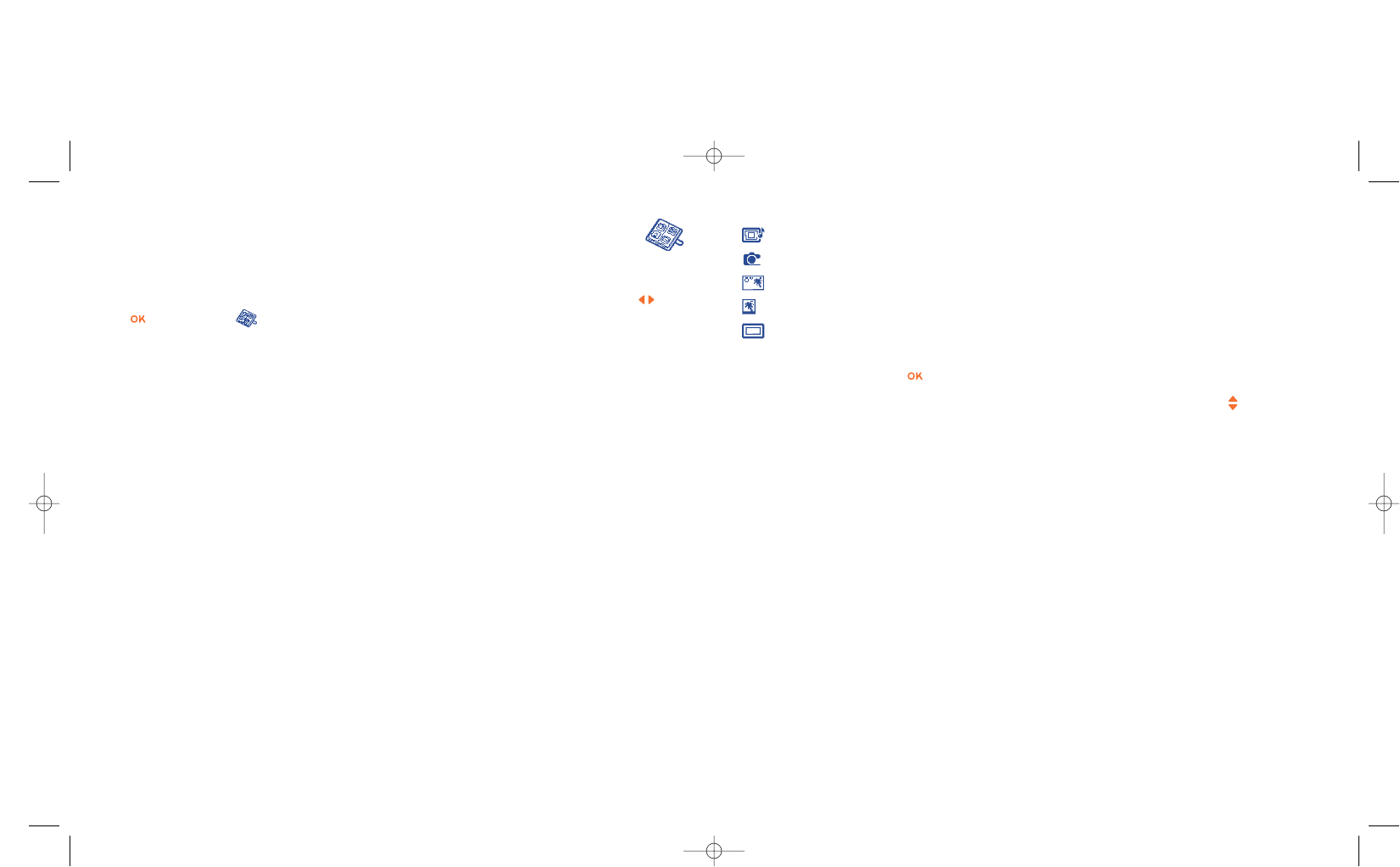
The Images album is made up of the following folders (1):
General, list of all images (built-in or created) from all album folders.
Photos, default folder for pictures taken with the camera.
Pictures, contains all images not belonging to one of the other folders.
Icons, contains EMS, stamps...
Frames, contains frames for enhancing your images.
For easier searching, the images/photos are displayed on the screen in reduced size. To view one image at
a time, select an image, press and click on “View”.
Then, from this view you can scroll through the images by making a short keypress on . Hold down the
key will start the slide show (or press the right softkey “Options” then “Slide show”).
76
(1) The embedded folder names cannot be modified. However, in certain cases, you can modify, delete and
add items included in these folders.
13 Media Album ..........................................
13.1 Album menu
To access the Album from the main screen, press the navigation key to the left or to the right (1) or
press and select the icon. The Album is a function that groups together all visual and sound items
in your telephone, regardless of whether they are embedded, downloaded, recorded or composed.
This function comprises three menus:
- the images album, containing images, icons, photos etc...
- the sounds album, containing sounds and melodies.
- the video album, containing videos.
In each of these three menus, you have the possibility to create new folders with the option “Create
folder”.
13.2 My Images
You can select an image or a photo and use it as the main screen or the ON/OFF screen. You may change
it, send it by MMS or assign it to a contact in the directory using the “Image” option (see page 33).
75
(1) Depending on your network operator.
CTH3_UM_FCC_15-03-05 15/03/05 9:18 Page 75
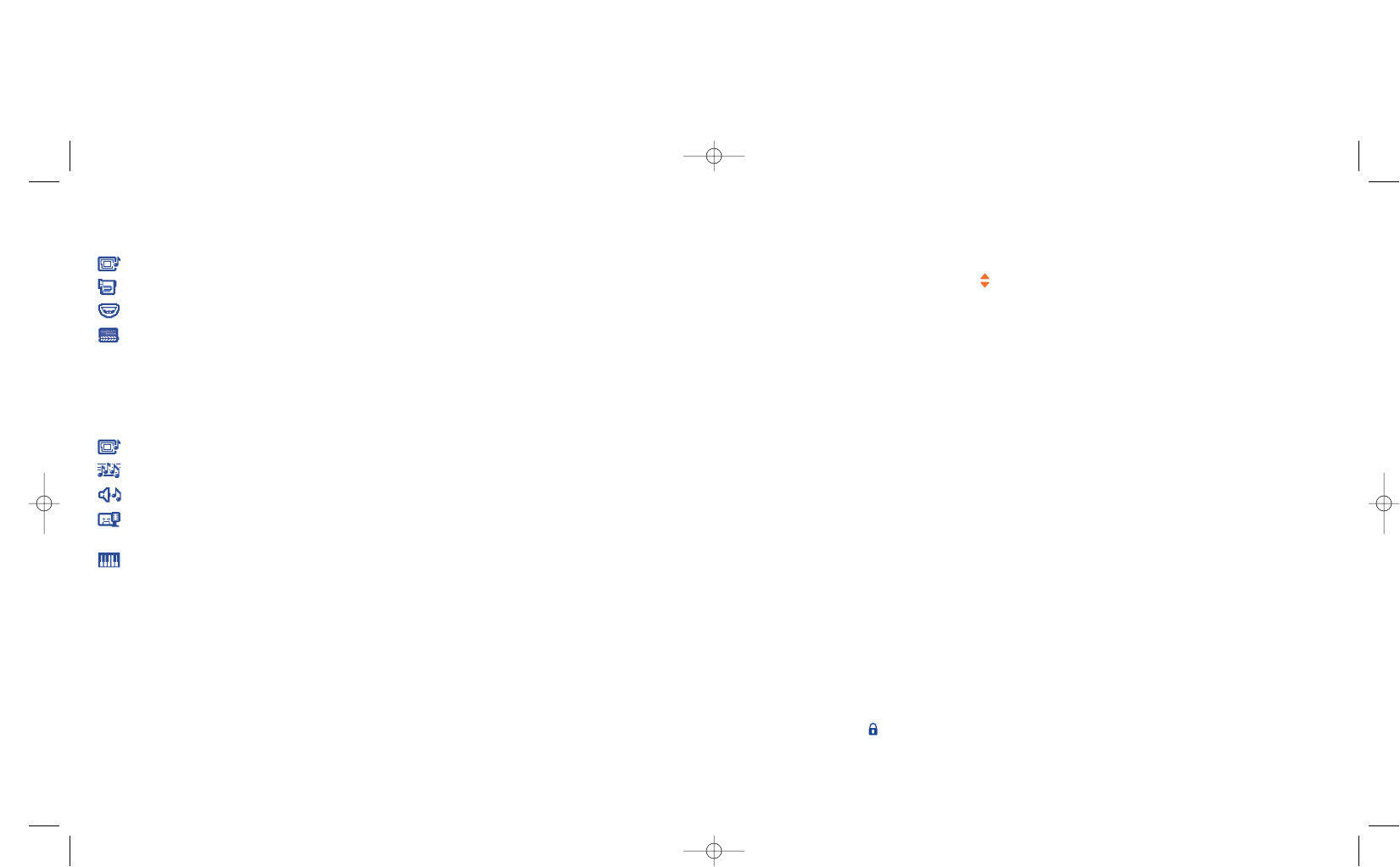
78
(1) Files marked with cannot be forwarded.
(2) Only applies to composed sounds and images that can be cleared.
13.5 Managing sounds, images and videos
According to the item chosen, you can access some of the functions below:
View •View the image selected. If you want to view all the pictures in your folder as a
slideshow, press on the current picture.
Listen to •Listen to the sound selected.
Play •Play the video selected.
Send (1) •Send sound/image/video.
Delete •Delete image/sound/video selected (not for some built-in items).
Set as •- Image->main screen, switch ON/OFF, assign it to a contact.
- Sound->ringtone, switch ON/OFF, assign it to a contact.
- Video->screen saver or assign it to a contact.
Ringtones •Choose a melody for an incoming call ringtone.
Modify •Modify sound/image (2).
13.3 My Videos
The “My Videos” Album is made up of the following folders (1):
General, contains all the items from all the folders (created, downloaded and embedded),
Recorded video, all the videos you have recorded,
Crazy clips,
Video trailers.
13.4 My Sounds
Choose a sound for the ON/OFF screen, for an incoming call, a message alert or an alarm (see page 49).
The “My Sounds” Album is made up of the following folders (1):
General, contains all sound items (built-in or created) from all album folders,
Melodies,
Crazy sounds,
Recorded sounds (only contains recordings made with the “Record” function and the “Memo
->Album” function),
Composed sounds (only contains compositions made using “Compose”).
77
(1) The embedded folder names cannot be modified. However, in certain cases, you can modify, delete and
add items included in these folders.
CTH3_UM_FCC_15-03-05 15/03/05 9:18 Page 77

80
13.7 Formats and compatibility
List of audio, image and video formats compatible with your telephone:
- Audio: AMR (.amr) (1); Midi (.mid); iMelody (.imy); Smaf (.mmf, .spf, .saf); Wav (8kHz, 16kHz and 24kHz
8bit)
- Image: JPEG (.jpg) (2); GIF (.gif); PNG (.png); BMP (.bmp)
- Video: 3GP (.3gp) (H263 (3) + AMR (1) or MPEG-4 (4))
MP4 (.mp4) (MPEG-4 (4))
- You can convert large image and sound files using the PC software suite so that they are compatible with
your terminal.
(1) AMR-NB.
(2) Except for progressive Jpeg. The telephone uses the “Independent Jpeg Group” code.
(3) H263 profile 0, level 10.
(4) MPEG-4 simple visual profile, level 0.
Download •Access your bookmark sites to download new items.
Rename •Rename sound/image/video.
Classify file •Move an image from one folder to another.
Create folder •Create folders grouping together a series of images or sounds (for example:
"Holidays" or "Birthday").
Delete folder •Delete this folder (if you created it).
Rename folder •Rename this folder (if you created it).
Empty folder •Empty this folder.
Sort by size/name •Sort the images by size or by alphabetical order.
Capture •Access the "Photo" or "Video" function directly.
13.6 Download new videos, photos, sounds, ...
With the “Download” option, you can access your favourite sites saved in your bookmarks list, and
download new items that you will be able to save in your Album.
79
CTH3_UM_FCC_15-03-05 15/03/05 9:18 Page 79

14.2 Burst shoots
Hold down the key or the upperside key.The shots are taken as long as the key is held down (maximum
number of pictures in a burst: 15). Then you can send this burst shoot in an MMS using the available options
(not available on VGA and Panoramic formats).
14.3 Taking a photo with sound
You can record a background sound, while you are taking a picture (hold down the lower side key). A screen
will prompt you to record your sound. When you release your finger, the recording will stop. Press to
return to the photo shot screen.
Please use your camera sensibly. Respect others and observe current regulations in your country.
8281
14 Camera ..................................................
Your telephone is fitted with a camera allowing you to take photos, short animations, and video clips that
you can use in different ways:
- store them in your “Media Album”,
- send them in a multimedia message (MMS) to a mobile phone or an e-mail address (see page 41),
- customise your main screen (see page 50),
- assign them to a contact in your directory (see page 33),
- transfer them by Infrared to your computer using Alcatel PC Suite,
- modify your photos adding frames, stamps, etc (see page 87).
14.1 Taking a photo
To access this function from the main screen, press the key.
Your phone must be switched on to take a photo. The screen acts as viewfinder. Position the object or
landscape in the viewfinder. The lens is situated on the back of the phone. Please do not touch it. Just next
to the lens there is a mirror to make sure you are well placed in order to take a photo of yourself.
You can take a photo in Portrait or in Landscape mode
- Portrait mode: short keypress on ;
- Landscape mode: short press on one of the side keys.
The shortcut to access the Camera feature from the main screen with the side keys, is disabled
when the flip is closed.
CTH3_UM_FCC_15-03-05 15/03/05 9:18 Page 81
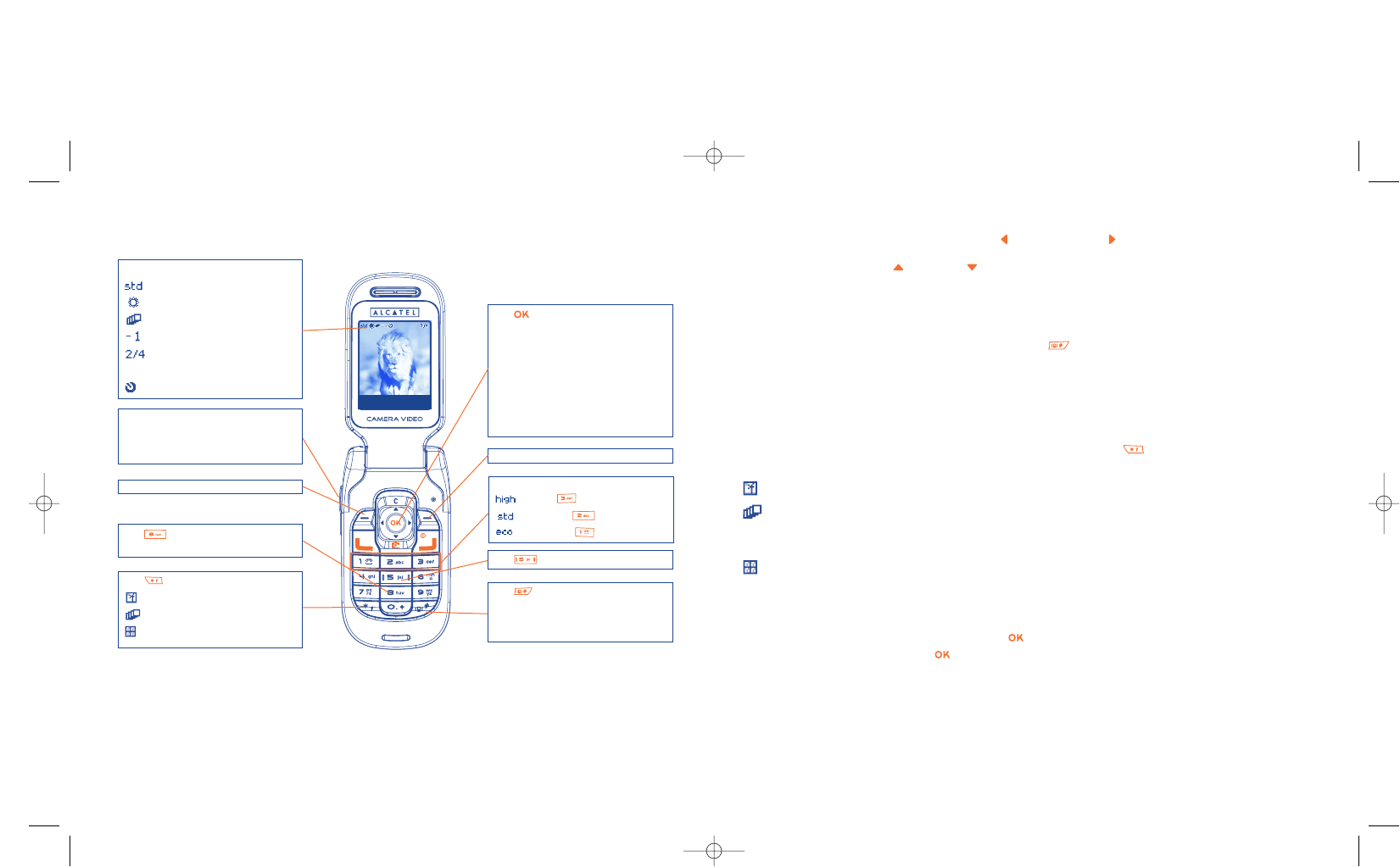
84
From the photo shot screen you can set the exposure and the zooming using the navigation key.
Exposure: adjust the contrast of your photo: underexposure, overexposure.
Zoom: activate the zoom: : zoom in, : zoom out (except for panoramic formats).
Press the right softkey to access the following options:
Image size
Select “Image size” in the list of options or press the key until you reach the size you require: VGA
(640x480), and Panoramic (640x360) optimised to be sent to a PC, XL (128x160), L (128x128) for local use
or MMS, M (64x64) to assign it to a directory file for instance, S (32x32) to create your very own stamps
(see page 87).
Capture mode
Select “Capture mode” in the options list or keep pressing the key to choose from one of the
following modes:
Single: a single photo; this is the default mode.
Animation x 4: in this mode, you can take 4 consecutive photos like a small slide show. The number
at the top right of the screen shows you which photo your are on: 1/4, 2/4, ....4/4. When you have
taken the 4th photo, the animation will start automatically.
Mosaic: in this mode, you will get an image made up of 4 thumbnails. To do this, proceed as for the
animation, once the “Mosaic” has been selected (see above).
Frame
Choose a frame from the list offered and press . The frame will be placed in your photo shot screen; if
the image is to your liking, press to take the photo. You will also find this option in the “Modify”
function (see page 87).
83
Selected options bar:
photo quality
white balance
capture mode
Exposure (over/under)
number of photos taken (for
animation and mosaic)
Timer
Left softkey: Shoot Quality:
: High - key
: Standard - key
: Economy - key
Key Capture mode
: Single
: Animation x 4
: Mosaic
Key : White balance
Right softkey: Options
Key :
- Short keypress: take a picture
- Long keypress: burst shoot
- Exposure:
Left: underexposure
Right: overexposure
- Zoom:
Up: zoom in
Down: zoom out
Key : Image size:
- Panoramic
- VGA
- XL/L/M/S
Key Colour mode: colour or
black&white
IFA BILDERTEAM/Agenceimages.com
14.4 Photo settings
Before taking the photo, you can adjust a number of settings.
Side keys :
- short press up or down : take a photo
- long press up : burst shoot
- long press down : take a photo + sound
Shoot Options
CTH3_UM_FCC_15-03-05 15/03/05 9:18 Page 83
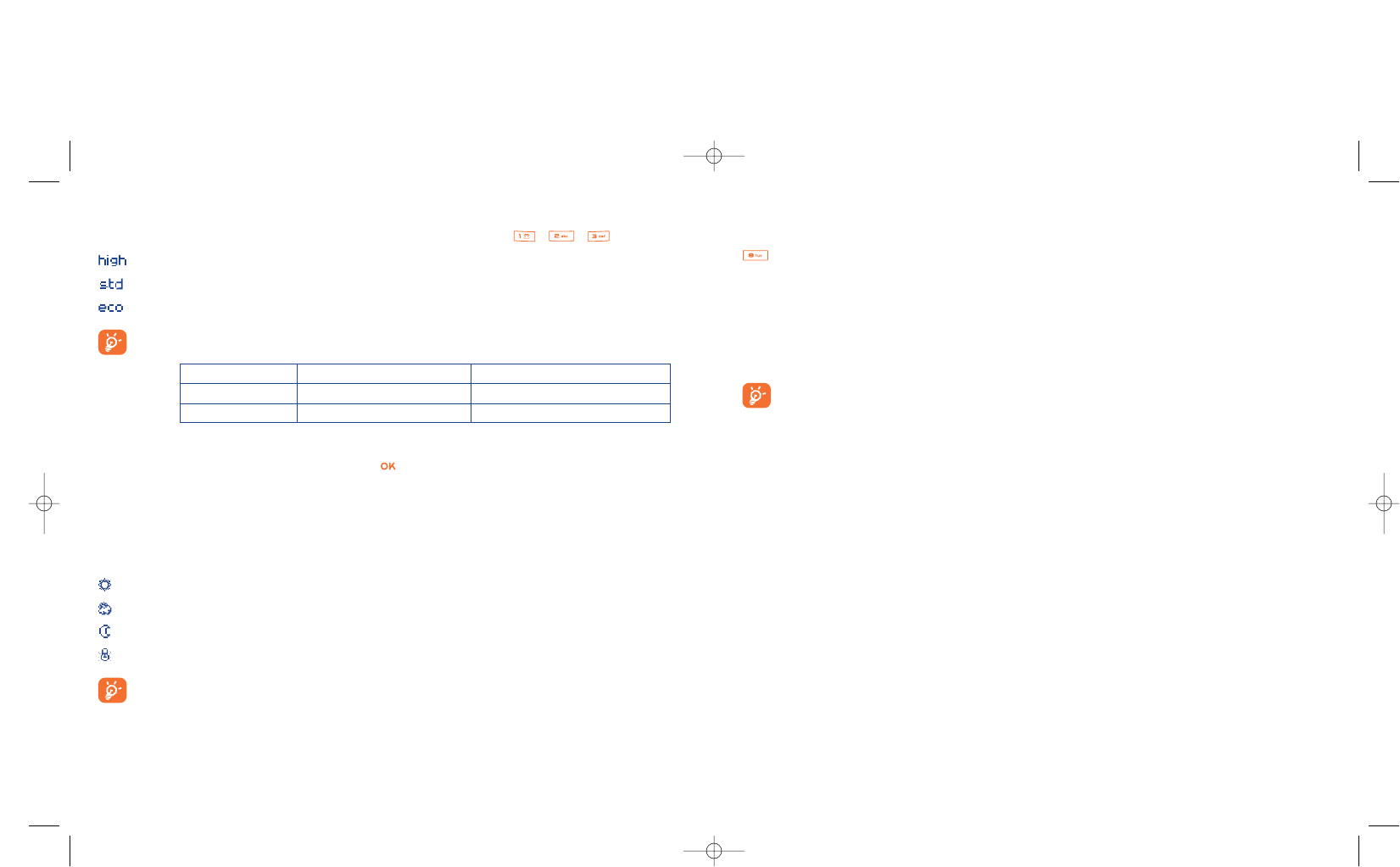
Colour
You can choose the colour effects. You can access this option from the photo shot screen by pressing the
key.
Direct access to the album (1)
With the option “Image Album”, you access the “Media Album” menu directly.
Folder by default (1)
You can change the folder where your photos will be stored automatically.
You can create your own folders using the “Media Album/My Images” option: “Create
folder” (see page 79).
Video access (1)
Exit the camera function and go to the video feature.
86
(1) Depending on cases.
Quality
Select “Quality” in the list of options or access it directly by pressing the , , keys:
: High quality: excellent quality to be sent to a PC,
: Standard quality: compromise between size and quality,
: Economy quality: memory space is optimised.
Warning: the higher the quality, the more memory is required. For example, if you have 1 MB of
free memory, you may store the following number of photos:
Format High quality Low quality
VGA 10 photos* 20 photos*
128 x 160 146 photos* 340 photos*
Timer
The photo will be taken 10 seconds after pressing . A sound will be emitted when you take a photo (if
your telephone is in Sound mode).
White balance
By pressing the “Options” function key, you can choose from 5 settings:
Auto: the settings adjust automatically (no icon will be displayed on your screen),
Sunny,
Cloudy,
Night time,
Indoor/artificial light.
In a dark atmosphere, select “Night” to improve the picture quality.
85
* These estimations are only given as an indication.
CTH3_UM_FCC_15-03-05 15/03/05 9:18 Page 85
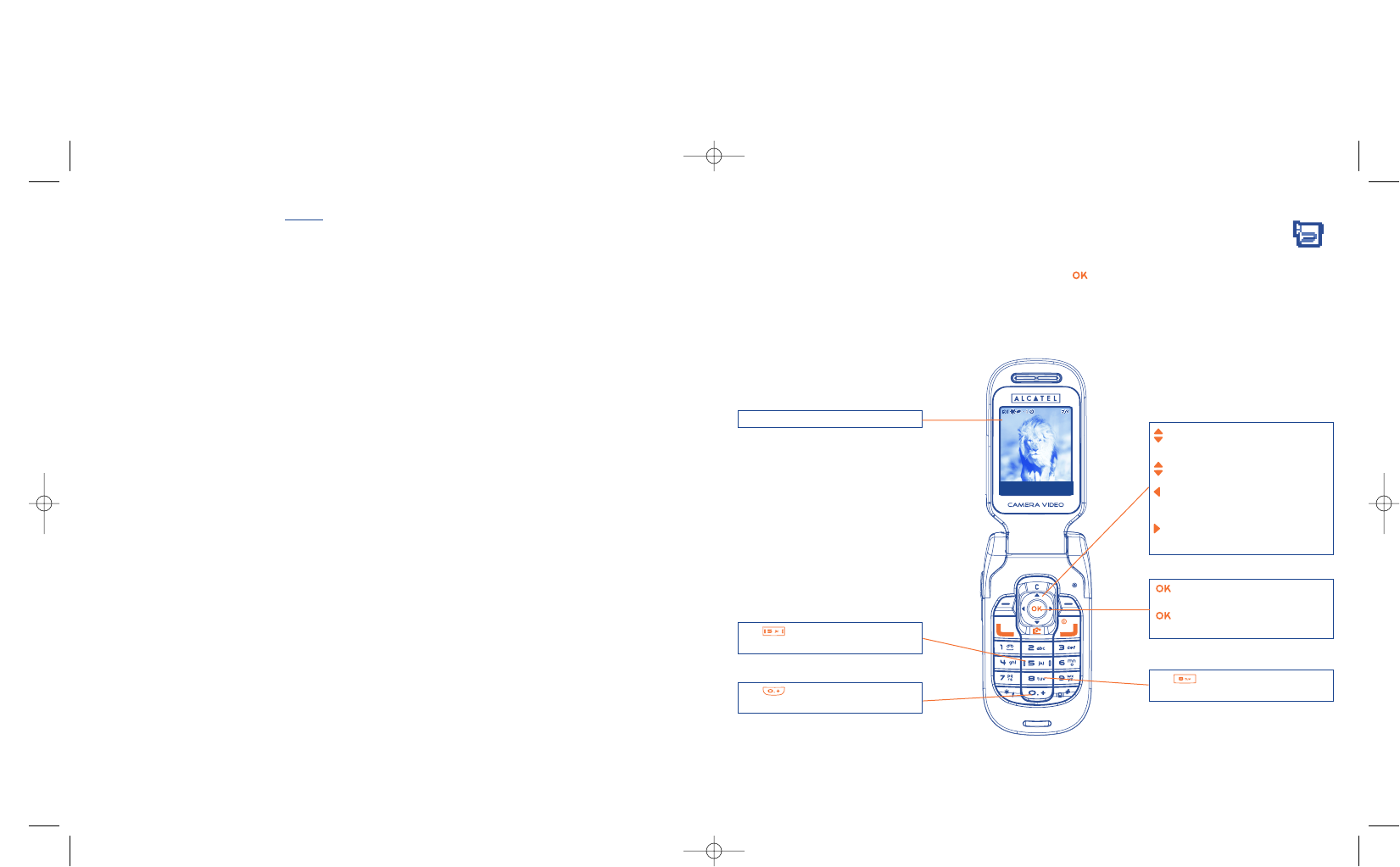
15 Video camera ........................................
To access this function from the main screen, press the key then, using the navigation key, select
“Photo/Video”. You can also configure a key for a direct access to this feature (see “Customising the
keys” page 54).
Video settings (direct access):
88
Viewfinder
Key : White balance settings (in
Framing mode)
Key : With sound / Without
sound (in Framing mode only)
:Zoom in/out (in Framing and in
Recording modes)
:Volume (in Playing mode)
:Underexposure
(in Framing mode only)
:Overexposure
(in Framing mode only)
key: Starts the recording (in
Framing mode only)
key: Stops the recording (in
Recording mode only)
Key : Colour settings
(in Framing mode only)
IFA BILDERTEAM/Agenceimages.com
Record Options
14.5 Options available after taking the photo
Once you have taken a photo or an animation, you can access the following options:
Send •Send your photo without saving it in the Album.
Save and send •Save your photo and send it.
Save •Save your photo.
Discard •Delete the photo you have just taken.
Modify •Reduce size, add stamps or frames.
Attach sound •Save a sound and assign it to the photo.
Image album •Access your Images Album directly.
Set as •Select what you want to do with your picture.
14.6 Modifying images
This option enables you to Reduce image size, or to Add stamps or Add frames. You have two
possibilities for accessing images in order to modify them:
- Via the “Media Album” menu:
Choose an image, press the “Options” softkey and select “Modify”.
- Via the “Photo/Video” menu (1):
After taking the photo, press the “Options” softkey and select “Modify”.
87
(1) The multimedia content (melodies, images, drawings, etc.) in this camera is for private use only, and
may not be used for commercial purposes. Violators are subject to prosecution.
CTH3_UM_FCC_15-03-05 15/03/05 9:18 Page 87

A bargraph indicates the elapsed time. During the recording, you can use the and keys to zoom in or
out.
In Recording mode with sound, you cannot receive any calls or messages.
In Recording mode without sound, if you receive a call, the recording is stopped and lost.
In Playing mode, side keys only may be used to modify the sound level.
15.3 Playing mode
After recording the video sequence, press the left softkey to play the video and decide what to do with it.
If you press the right softkey, you will access the following options:
Save •Save the video in the Video album in the product memory and return to Framing
mode. A name is automatically given. Then, you can modify it in the "Video
Album”).
Play •Play the video sequence. Adjust the volume with the keys or with the keys on
the side of your phone.
Send •You can send your video clip either by Infrared or by MMS (if ≤10 seconds)
without saving it.
Save and send •Same as “Send” but the video clip will be saved in the Album.
Discard •Cancel the video sequence and return to Framing mode.
Set as •Allows you to use the video clip either to assign it to a contact (in phone directory
only) or as a screen saver (see page 51).
Default folder •Change the default folder where videos will be stored when saved.
90
15.1 Framing mode
When you enter the “Video” function, you are in Framing mode. Use the telephone screen as a viewfinder
and press the softkey “Options” to access the various settings before recording:
MMS video (1) •Choose between short video (10 seconds) that you can send by MMS or IrDA and
long video (30 seconds) that you can transfer by IrDA only.
White balance •Choose the lighting setting: auto/shiny/cloudy/night/indoor.
Without / With •Activate or deactivate the recording of sounds.
sound (1)
Colour •Choose the colour effect of your clip: Colour or Black and White.
Video album (1) •Access the Video Album.
Access camera (1) •Exit the “Video” function and move to the “Camera” function.
Default folder (1) •You can change the default folder where videos will be stored when saved.
Memory space
A 10-second video clip takes about 100 kB memory space. Therefore, if you have 1 MB free memory in your
telephone, you can still record about 10 clips (this estimation is given as an indication only).
15.2 Recording mode
Once you have chosen your settings, you can launch the recording of your video-clip by pressing the
"Record" softkey or the key; a short beep is emitted.
89
(1) Depending on cases.
CTH3_UM_FCC_15-03-05 15/03/05 9:18 Page 89
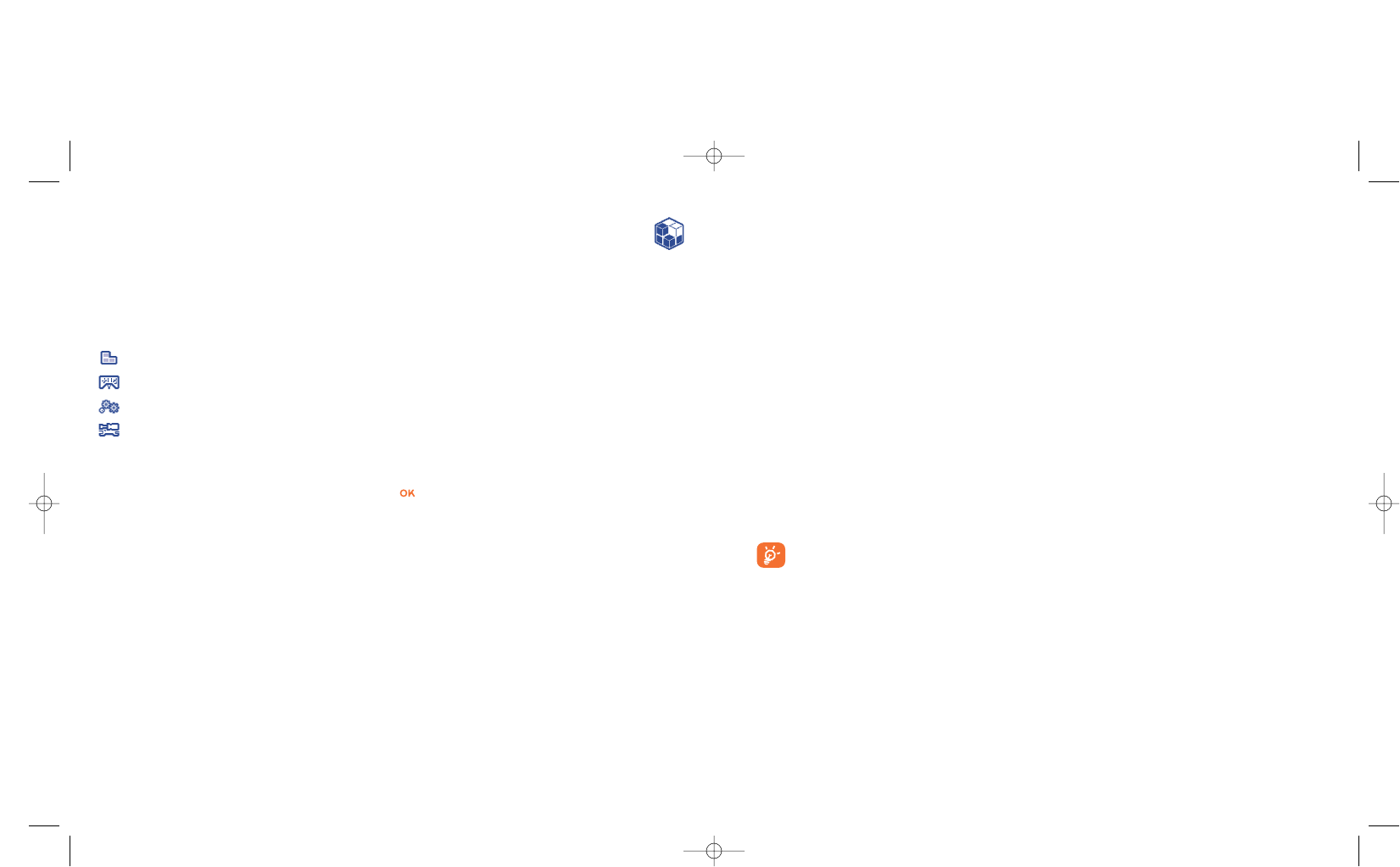
92
(1) For the availability of different WAP services, pricing and tariffs, contact your network operator and/
or the WAP service provider.
16.2 Available options
Launch •Launch the application.
Information •This option gives information on the application.
Download •Download an application.
Delete •Deletes the application. If you delete a pre-installed application in your phone,
you may, depending on the application:
- download it again from the My One Touch server, www.tcl-alcatel-mp.com
- download it again from your operator’s Website. Contact your operator for
further information.
However, some applications cannot be re-downloaded.
Classify •Classify in “Games” or “Applications”.
16.3 Download an application
You can download new Java™ applications in 2 ways:
- Either, in the “Games & Apps” menu by selecting the “Download” softkey. The list of available WAP
bookmarks dedicated to the application download will then be displayed. Select the appropriate
bookmark to go to the desired WAP page.
You can download a Java™ application only if the WAP profile is activated (1) (see page 71).
91
16 Games & Applications ............................
Your phone may include (1) some Java™ applications and games. You can also download new applications and
games to your phone from other service providers (2).
The “Games & Apps” menu allows you to manage the Java™ applications installed in your phone. It
includes three directories and one configuration folder:
General: contains all applications and games,
Games: contains the games,
Applications: contains the other applications,
Settings: contains your sound, backlighting and network settings.
16.1 Launch an application
Select the application. Press the “Launch” softkey or then “Launch”.
(1) Depending on your country or your operator.
(2) Requires access to WAP services (see page 71).
CTH3_UM_FCC_15-03-05 15/03/05 9:18 Page 91

94
Disclaimer
Downloading or running applications will not damage or alter any software already in your mobile telephone
designed to support Java™ technology.
TCL & Alcatel Mobile Phones Limited and its affiliates waive any responsibility and refuse to guarantee
applications that are subsequently used, as well as for all applications not embedded in the handset upon
purchase.
The purchaser alone bears the risk of loss, damage or defect of the handset, or of applications/software, and
generally of any damage or consequence resulting from the use of the said applications/software. In the event
the said applications/software, or the subsequent setup of any function are lost due to technical reasons if
the handset is replaced/repaired, the mobile phone owner should repeat the operation and download or set
up again. TCL & Alcatel Mobile Phones Limited and its affiliates grant no guarantee and disclaim any
responsibility if the operation cannot be repeated or cannot be performed without incurring additional
costs.
Java™ and all Java™ based trademarks and logos are trademarks or registered trademarks
of Sun Microsystems, Inc. in the U.S. and other countries.
Powered by JBlend™ - Copyright 1997-2003 - Aplix Corporation. All rights reserved.
JBlend™ and all JBlend™-based trademarks and logos are trademarks or registered
trademarks of Aplix Corporation in Japan and other countries.
93
- Or, from the main screen by selecting “WAP” then “Bookmarks” and choosing “My One Touch”.
The downloaded applications can be saved either in the Games folder or Application folder.
16.4 Java™ Push
Depending on your server/operator, you may receive Java™ Push messages inviting you to launch new
applications they propose.
16.5 Settings
-Sound Switch sound ON/OFF for all applications.
-Backlight Activate or deactivate the backlight.
-Network List of network profiles available for Games & Applications. This list comprises the current
WAP profiles and specific profiles for Games & Applications. To select a profile, go to the list,
press and select “Confirm”. To modify a specific profile for Games & Applications, go to
the list, press and select “Modify”. To create a profile, go to the list, press and select
“Create”. For the options available, see page 74.
-Memory View memory available. Applications use shared memory (see page 66).
While an application is running
- Short keypress on : pause
- Hold down the key: exit the application
Authorisation for network access: some applications require network access or the sending of an SMS. In
this case, select the authorisation profile required with the navigation key , press then validate the
selection then press “Confirm” to validate everything.
CTH3_UM_FCC_15-03-05 15/03/05 9:18 Page 93
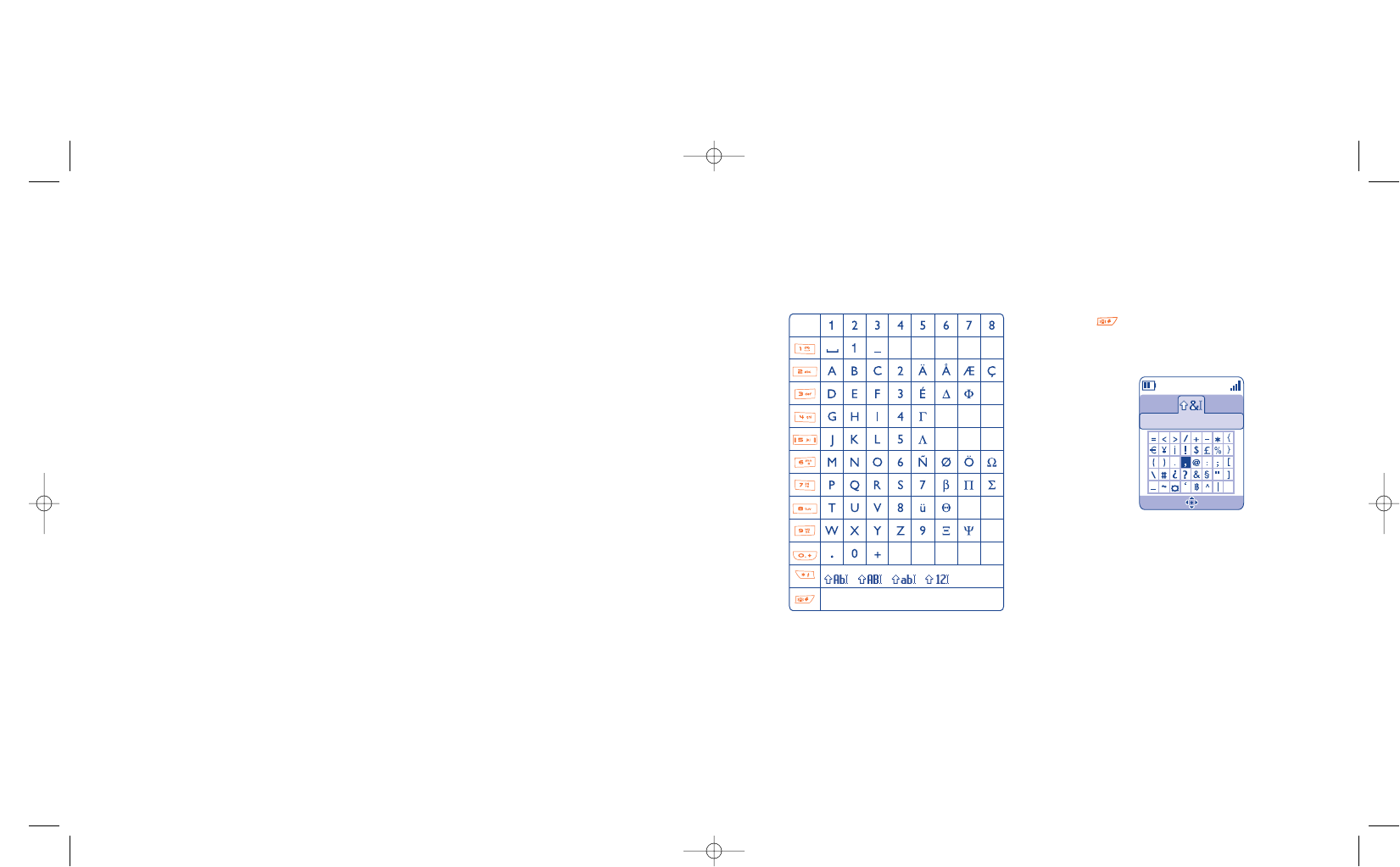
18 Characters and symbols table ....................
To enter a word in normal mode, press the key corresponding to the desired letter several times until the
letter appears.
96
Press the key to display the symbols table; the
cursor is positioned in the centre. Use the navigation
key to move it.
, , , (see p. 45)
Displays the symbols table
Symbols table
17 Making the most of your mobile................
17.1 “My One Touch” services by TCL & Alcatel Mobile Phones
On our website you will find all the services available to make the most of your mobile telephone.
Go to “www.tcl-alcatel-mp.com” or simply choose the “My One Touch” option in your mobile
telephone. Access this by selecting “Services” or “My settings/Ringtones” or “Media Album/My
Images/Download” from the main menu.
17.2 Alcatel PC suite
Depending on your model, your packaging box may contain a PC suite. Otherwise, you can download it for
free from our website. The PC suite includes:
- Multimedia Studio:
•customise your mobile with sounds, melodies, images, animations and videos.
•transfer to your PC the photos and videos taken with your camera.
- One Touch Sync:
•synchronise your mobile phone with: MS Outlook 98 / 2000 / 2002 / 2003, Outlook Express 5.0 / 6.0,
Lotus Notes 4.6 / 5.0 / 6.0 / 6.5, Lotus Organiser 5.0 / 6.0
- Data Connection Wizard:
•use your mobile phone to connect your PC to the internet.
Supported Operating Systems
- Windows 2000 with Service Pack 4 (SP4) or later
- Windows XP with Service Pack 1 (SP1) or later
95
CTH3_UM_FCC_15-03-05 15/03/05 9:18 Page 95

6) modifications, alterations, or repairs carried out by parties not authorized by TCL & Alcatel Mobile Phones Limited or
its affiliates, the dealer or the approved maintenance center,
7) use of the equipment for a purpose other than that for which it was designed,
8) normal wear,
9) deterioration caused by external causes (RF interference produced by other equipment, fluctuations in mains voltage
and/or voltages on telephone lines, etc),
10)modifications made to the equipment even if they are unavoidable due to changes in regulations and/or modification of
network parameters,
11)connection faults resulting from unsatisfactory radio transmission or caused by the absence of radio relay coverage.
Equipment on which markings or serial numbers have been removed or altered, and handsets on which labels have been
removed or deteriorated shall be excluded from the warranty. The above provisions constitute the only claims which can
be made against the manufacturer and dealer on the grounds of equipment defects, this warranty excludes any other explicit
or implied warranty except the statutory warranty in force in the user’s country.
There are no express warranties, whether written or oral, other than this printed limited warranty. All implied warranties,
including without limitation the implied warranties of merchantability or fitness for a particular purpose, are limited to the
duration of this limited warranty. In no event shall TCL & Alcatel Mobile Phones Limited or its affiliates be liable for
incidental or consequential damages of any nature whatsoever, including but not limited to loss of profits, commercial loss,
to the full extent those damages can be disclaimed by law. Some countries/states do not allow the exclusion or limitation
of incidental or consequential damages, or limitation of the duration of implied warranties, so the preceding limitations or
exclusions may not apply to you.
9897
19 Telephone warranty ....................................
Congratulations on choosing this cellphone - we hope that you will be totally satisfied with it.
Notwithstanding any other applicable statutory warranties, this cellphone is guaranteed against any manufacturing defect for
a period of ONE (1) year from the date of purchase shown on your invoice. Nevertheless if the statutory warranty in force
in your country exceeds one (1) year, the statutory warranty is not affected by the manufacturer’s warranty. The present
warranty terms also apply to the battery and accessories but for a period of SIX (6) months from the date of purchase
shown on your invoice.
Under the terms of this warranty, you must inform your dealer or any maintenance center (see list of maintenance centers
on our website - www.tcl-alcatel-mp.com) without delay, of any defect and present the invoice given to you at the time of
purchase. The vendor or maintenance center will decide whether to replace or repair, as appropriate, all or any part of the
equipment (telephone or accessory) found to be defective. This warranty covers the cost of parts and labor but excludes
any other costs. Repair or replacement may be carried out using reconditioned components offering equivalent
functionality.
Servicing under the terms of this warranty, especially repair, modification or replacement of parts shall entitle to a THREE
(3) month warranty unless there are statutory provisions to the contrary.
This warranty shall not apply to damage or defects (to your telephone and/or accessory) caused by:
1) use not conforming with the instructions for use or installation,
2) non observation of the technical and safety standards applicable in the country where the equipment is used,
3) improper maintenance of batteries and other sources of energy, and of the overall electric installation,
4) accidents or the consequences of theft (of the vehicle), acts of vandalism, lightning, fire, humidity, infiltration of liquids,
atmospheric influences,
5) combination or integration of the equipment in hardware not supplied or not recommended by TCL & Alcatel Mobile
Phones Limited or its affiliates, without their express written consent for such,
CTH3_UM_FCC_15-03-05 15/03/05 9:18 Page 97
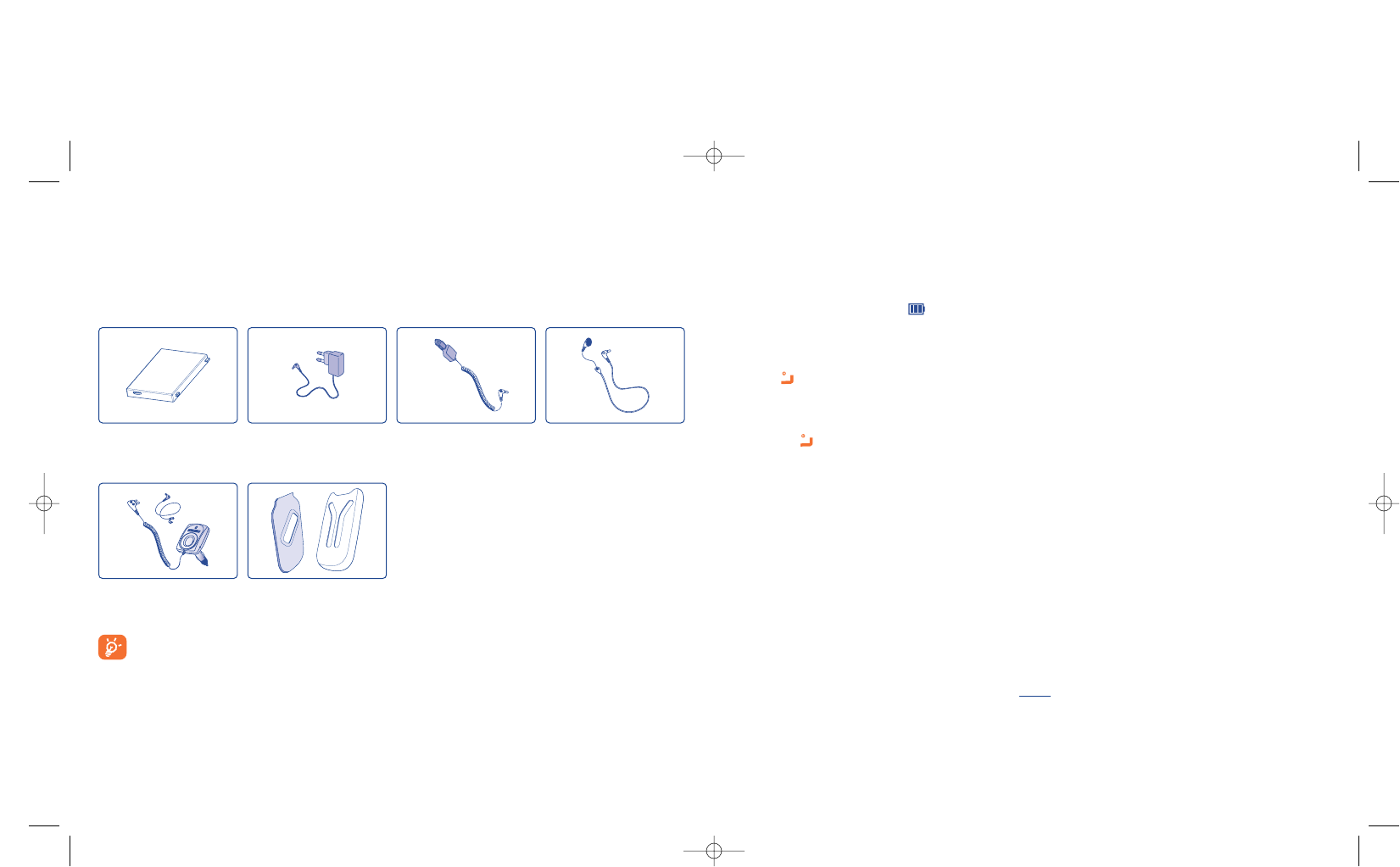
100
21 Troubleshooting ..........................................
Before contacting the aftersales department, you are advised to follow the instructions below:
•You are advised to switch off the telephone from time to time to optimise its performance.
•You are advised to fully charge ( )the battery for optimal operation.
•Avoid storing large amounts of data in your telephone as this may affect the performance of your telephone.
and carry out the following checks:
My mobile phone does not switch on
•Press until the screen comes on
•Check the battery charge level
•Check the battery contacts, remove and reinstall your battery, then turn your telephone back on
My phone has not responded for several minutes
•Press the key
•Remove the battery and re-insert it, then switch the phone back on
My screen is difficult to read
•Clean your screen
•Use your mobile phone in accordance with the recommended conditions of use
My mobile phone turns off by itself
•Check that your keypad is locked when you are not using your mobile phone
•Check the battery charge level
My mobile phone has a low level of autonomy
•Make sure you respected the complete charge timing (minimum 3 hours)
•After a partial charge, the battery level indicator may not be exact. Wait for 20 minutes minimum after removing the
charger to obtain an exact indication
My mobile phone does not charge properly
•Make sure that your battery is not completely discharged; the battery charge indicator can take several minutes and may
be accompanied by a quiet whistling sound
•Make sure charging is carried out under normal conditions (0°C +40°C)
•Make sure your battery is inserted. It must be inserted before plugging in the charger
•Make sure you are using an Alcatel battery and charger
•When abroad, check that the electrical current is compatible
20 Accessories (1)................................................
The latest generation of Alcatel GSM mobile phones offers a built-in handsfree feature that allows you to
use the telephone from a distance, placed on a table for example. For those who prefer to keep their
conversations confidential, an earpiece is also available known as the headset.
99
Battery
BC-10241
Charger
C55X
Cigar lighter charger
C56
Headset
M13
Basic car kit
MP79
Removable covers
FPC- 10839- A*
(1) Depending on availability.
Only use your telephone with Alcatel batteries, chargers and accessories compatible with your
model.
CTH3_UM_FCC_15-03-05 15/03/05 9:18 Page 99

When I select a number from my directory, the number is not dialled
•Make sure that you have correctly recorded the number in your file
•Make sure that you have selected the country prefix when calling a foreign country
I am unable to create a file in my directory
•Make sure that your SIM card directory is not full; delete some files or save the files in the product directory (i.e. your
professional or personal directories)
•Check the “Call barring” option for “Incoming calls” to be sure that the “Incoming call except directory” feature
is not activated
My callers are unable to leave messages on my voicemail
•Contact your network operator to check service availability
I can’t access my voicemail
•Make sure your operator’s voicemail number is correctly entered in “My Numbers”
•Try later if the network is busy
I am unable to send and receive messages MMS,Vox MMS
•Check your phone memory available as it might be full (see page 66)
•Contact your network operator to check service availability and check MMS parameters (see page 47)
•Verify the server centre number or your MMS profile with your operator
•The server centre may be saturated; try again later
The icon is displayed on my standby screen
•You have saved too many short messages on your SIM card; delete some of them or archive them in the product memory
The << - >> icon is displayed
•You are outside of the network coverage area
I have already entered 3 incorrect PIN codes
•Contact your network operator to obtain the PUK code (Personal Unblocking Key)
I am unable to connect my telephone to my computer
•Install first of all Alcatel’s PC suite
•Use “Install the connection” and perform the installation
•If you use the infrared port, check that it is correctly activated (see page 67)
•If you use infrared often, we advise that you set a quick access to it from the keypad (see page 54).
•Check that your computer meets the requirements for Alcatel’s PC Suite installation
102
My mobile phone does not connect to a network
•Try connecting in another location
•Verify the network coverage with your operator
•Check with your operator that your SIM card is valid
•Try selecting the available network(s) manually (see page 58)
•Try connecting at a later time if the network is overloaded
SIM card error
•Make sure the SIM card is correctly inserted (see page 13)
•Verify with your operator that your SIM card is 3V compatible; the old 5V SIM cards cannot be used
•Make sure the chip on your SIM card is not damaged or scratched
Unable to make outgoing calls
•Make sure you have dialled a valid number and press the key
•For international calls, check the country and area codes
•Make sure your mobile phone is connected to a network, and that the network is not overloaded or unavailable
•Check your subscription status with your operator (credit, SIM card valid, etc.)
•Make sure you have not barred outgoing calls (see page 25)
Unable to receive incoming calls
•Make sure your mobile phone is switched on and connected to a network (check for overloaded or unavailable network)
•Check your subscription status with your operator (credit, SIM card valid, etc.)
•Make sure you have not forwarded incoming calls (see page 24)
•Make sure that you have not barred certain calls
The caller’s name does not appear when a call is received
•Check that you have subscribed to this service with your operator
•Your caller has concealed his/her number
The sound quality of the calls is not optimal
•You can adjust the volume during a call by means of the key
•Check the radio reception icon level
I am unable to use the features described in the manual
•Check with your operator to make sure that your subscription includes this service
•Make sure this feature does not require an Alcatel accessory.
101
CTH3_UM_FCC_15-03-05 15/03/05 9:18 Page 101

Alcatel logo and Alcatel name are trademarks of Alcatel
used under license by TCL & Alcatel Mobile Phones Limited.
All rights reserved © Copyright 2004 TCL & Alcatel Mobile Phones Limited.
TCL & Alcatel Mobile Phones Limited reserves the right,
in the customer’s interest, to alter material or
technical specification without prior notice.
English - 3DS10948AAAA 01-FCC
CTH3_UM_FCC_15-03-05 15/03/05 9:18 Page 103